Solving Case Studies: 8 Step-by-Step Strategies for Management Students
- by Tanu Bhatnagar
- Published: Oct 08, 2023, 09:45 IST
- Updated: Oct 08, 2023, 00:54 IST
- Tanu Bhatnagar
- October 8, 2023

Mastering the Art of Analyzing and Resolving Business Case Studies
Case study analysis is useful for management students. It’s more than a course—it’s a preview of your future job problems. These real-life examples allow you to apply class ideas and acquire a business-ready problem-solving attitude.
It’s not easy to master case study solving. Strategic thinking, critical thinking, and innovation are needed. This book covers the finest case study solution tactics to help you succeed academically and become a good manager. Solving a management case study is a crucial skill for students pursuing degrees in fields such as MBA, HRM, Finance, and Marketing.
Also, read 10 Proven Memorize Techniques for Students- Friendly Tips
8 Step-by-Step Strategies for Management Students
These case studies offer a practical application of management concepts, requiring students to analyze complex scenarios and devise solutions. In this comprehensive guide, we will outline a step-by-step approach to solving management case studies and provide a real-world example with a solution.
Step 1: Comprehensive Case Study Analysis
Comprehensive case study analysis is the cornerstone of effective problem-solving. It involves immersing yourself in the case study, not just skimming through it. Start by reading the case thoroughly, absorbing its context, characters, and central problem or objective. It’s crucial to understand the nuances of the situation presented, as even subtle details may significantly impact the solution.
During this phase, consider the following:
- Context : Understand the setting, time frame, and circumstances that led to the current situation.
- Characters : Familiarize yourself with the key individuals involved, their roles, motivations, and potential biases.
- Problem/Objective : Identify the core challenge or goal that the case revolves around.
Step 2: Familiarize with the Industry and Company
Familiarizing yourself with the industry and the specific company involved in the case study is pivotal. This step provides essential context and aids in making informed decisions and recommendations. Here’s how to approach it:
- Industry Analysis : Research the industry’s characteristics, trends, and dynamics. This knowledge helps you understand the broader competitive landscape and market forces at play.
- Company Background : Delve into the company’s history, products or services, market position, financial performance, and strategic priorities. This information helps you align your recommendations with the company’s goals and capabilities.
Step 3: Define the Core Problem/Objective

In this step, your objective is to pinpoint the primary issue or objective that the case study revolves around. By clarifying the problem that needs resolution or the goal that must be achieved, you set the stage for your analysis and decision-making. Consider the following:
- Problem Statement : Summarize the problem in a concise, clear statement. Ensure that your understanding aligns with the essence of the case.
- Objective Clarity : If the case involves an objective, such as expanding market share or improving profitability, define it with precision.
Step 4: Extract Relevant Information
A key aspect of case study analysis is extracting relevant facts and details from the case materials. This process involves revisiting the case study, both to reinforce your understanding and to gather pertinent information. Here’s how to approach it:
- Detailed Examination : Scrutinize the case for data, statistics, anecdotes, and any other information that sheds light on the problem or objective.
- Note-taking : Create a system for recording critical information, whether through written notes or mental models. This will aid in organizing your analysis.
Step 5: Identify Key Statements

Within the case study, there are often statements or pieces of information that hold particular significance. These statements can serve as guideposts during your analysis, helping you define and address the problem more precisely. Consider:
- Problem Clues : Look for statements that hint at the underlying issues or challenges.
- Objective Relevance : Identify statements that directly relate to the stated objective.
Step 6: Assess the External Environment
To make informed recommendations, you must assess the external environment surrounding the case. This step involves considering various factors that can influence the solution, including:
- Market Conditions : Analyze the market’s size, growth rate, trends, and competitive landscape.
- Regulatory Environment : Evaluate the impact of regulations, laws, and government policies on the case.
- Resource Availability : Understand the availability of resources, such as capital, talent, and technology.
- Competitive Forces : Assess the competitive forces at play, including existing rivals, potential entrants, suppliers, and buyers.
Also, read Top 10 Hobbies That Boost Your IQ: A Guide for Students
Step 7: Address Real-Life Constraints
Recognize that real-life problem-solving often comes with limitations, including incomplete information and time constraints. You should be prepared to make decisions based on the available data and within reasonable time limits. Consider:
- Time Sensitivity : Acknowledge any time pressures that may affect the decision-making process.
- Resource Constraints : Understand the limits of available resources, such as budget, manpower, or technology.
Step 8: Fill Information Gaps with Realistic Assumptions
Information gaps are common in real-world scenarios. To bridge these gaps, make realistic assumptions that align with the context of the case study. Use your judgment and critical thinking to supplement missing details while staying grounded in the case’s reality.
By following these steps diligently, you can approach management case studies methodically and develop well-structured, informed solutions that address the core problem or objective effectively

Problem: XYZ Corporation, a well-established software development firm, is grappling with ongoing employee performance challenges. Several members of its software development team consistently fail to meet project deadlines and produce work below the company’s quality standards.
Problem Question 1: What is the core problem that XYZ Corporation is facing concerning employee performance?
The central issue that XYZ Corporation is confronting concerning employee performance is the persistent underperformance of several software developers within the organization. These individuals consistently fail to meet project deadlines and produce work that falls significantly below the company’s established quality standards. This recurring problem has become a significant impediment to the company’s software development projects.
Problem Question 2: How are the underperforming employees affecting the company’s software development projects and overall business operations?
The underperforming employees in XYZ Corporation are having a substantial negative impact on the company’s software development projects and overall business operations. Their consistent inability to meet project deadlines results in significant delays in project completion, disrupting project schedules and affecting the company’s ability to deliver products and services on time. Furthermore, the compromised quality of their work leads to subpar products, potentially resulting in client dissatisfaction and eroding the company’s reputation. These issues collectively undermine the company’s profitability as it grapples with missed opportunities and the costs associated with addressing substandard work. Addressing this challenge is imperative for XYZ Corporation to ensure its continued success and competitiveness in the software development industry.
. Student Approach to Solve:
- Begin by thoroughly reading the case study to grasp its context, characters, and the central problem or objective.
- Understanding the broader business environment will aid in making informed decisions and recommendations.
- Identify the primary issue or objective in the case.
- Create a mental or written model of the core problem or objective and make note of critical information that informs your understanding.
- Acknowledge that real-life problems often come with incomplete information and time constraints.
- Use your judgment to supplement missing details.
By following these steps and considering the provided answers, students can approach and solve the case study effectively, offering valuable insights and recommendations to address XYZ Corporation’s employee performance challenges.
Finally, the case study solution connects management theory with practice. It helps students analyse difficult circumstances, make educated judgements, and find effective solutions, which employers in numerous sectors value.
The above guide’s techniques can help students succeed in management school and prepare them for job difficulties and possibilities. Accept case studies as learning opportunities, improve your problem-solving abilities, and become a skilled and resourceful manager. The greatest method to learn is through doing, and case study solution leads to real-world success.
Also, read 10 Best Economic Books for Commerce Students

Meet Tanu Bhatnagar, an educational expert with extensive experience in teaching, research and mentoring.With a decade in... (Full bio)
Latest Exams
Best colleges.

Trending News

Best Books to Read in 2023
Best Books to Read in 2023 Are you a bookworm or a bibliophile, if yes, then this is the ...

10 Proven Memorize Techniques for Students- Friendly Tips
In the exhilarating journey of 10 Proven Memorize Techniques for Students learning, memory is your trusty companion. Whether ...

Top 20 Toughest exams in world Latest List 2023
Top 20 toughest exams in world is about exams in the world that required very hard work to ...
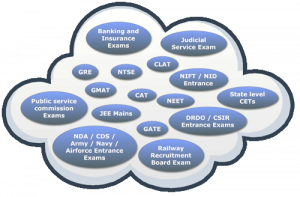
Top 20 toughest exams in India Latest List 2023
Top 20 toughest exams in India - Exams are the perhaps most toughest moments for any student. A ...

Top 20 Colleges of DU Latest List 2023
Top 20 Colleges of DU Getting admissions to the top 20 colleges of DU is a dream for every ...

Top 20 NITs of India Latest List 2023
Top 20 NITs of India - Amongst the 31 NITs in India, today, we are talking ...

Top 12 Artificial Intelligence Colleges in Mumbai
Here are the Top 12 Artificial Intelligence in Mumbai. Artificial intelligence (AI) refers to the simulation of human ...
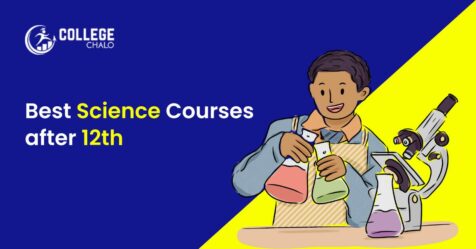
Best Science Courses after 12th
As you stand on the Best Science Courses after 12th academic journey, the realm of science beckons, offering ...
Curated Latest News For You

JEE Advanced 2023 provisional answer key, access links here

Best 5 Time Management Tips for Competitive Exams

JEE Advanced 2023 registration starts on 30 April 2023

Score High in NEET 2023 With these Key Subject wise topics

Top 8 Jobs in Indian Army after Plus Two

10 Super Tips for Cracking NEET 2023
The sooner you start, the better .
Millions of students have entrusted CollegeChalo to facilitate their seamless and smooth admission process to their dream colleges and universities. With CollegeChalo, you can gain a competitive edge by easily accessing exam and course details to stay ahead of the admission journey. What are you waiting for?
ADMISSION ENQUIRY FORM
Enter basic details, signin with google, or use your email, signup with google, forgot your password, resetting new password, connecting you to your dream college.
Discover Leading Universities and Colleges, Explore Courses, and Navigate Exams
search results:
How CollegeChalo helps you in admission ?
- With a completely online admission process, we help you get college admission without having to step out.
- Upto 50% discount on application forms
- 24*7 counselling facilities available
- Ask and receive answers from experts and other users

Download the Unstop app now!
Check out the latest opportunities just for you!
How To Solve Case Study? (A Strategy By IIM L Student That Works Every Time!)
Table of content:
- Step 1: Identify the problem statement
Step 2: Propose solutions with a pinch of creativity
Step 3: establish the scale and impact of the solution.
“Case study competitions” - Something that is arguably one of the most valuable parts of your MBA life. But this may be daunting for many. Maybe you’re not sure which case competitions to participate in, so you pile too much on your plate. Maybe you’re not sure about the right way to solve a case study. In this article, we’ll break down everything you need to know about acing a case study competition, from scratch!
A case study competition can be an academic or corporate competition in which participants come together to solve either a real-world case or a framed case that is presented. We present to you Muskan Atar, who will walk you through her tested strategy to solve case study competitions and win them in style!

Framework to solve case studies
After participating in 7-8 case competitions, I realized I had been unconsciously solving it using the same framework. It is very similar to the framework used for product management cases. Hence, it didn't disappoint me.
Step 1: Identify the problem statement
Case competitions like Accenture Strategy Case Connect and Colgate Transcend provide an exact problem statement with the expected outcome. But, in most cases, we must dive deep to break down the problem statement and identify the potential causes.
Like, for Colgate Transcend, the problem statement was (summary) -
Should Colgate diversify into Electric Tooth Brush (ETB) Segment? If yes, then how?
Here, we identified the problems through secondary research (reports from consultancy firms) and primary research (customer surveys). The problem statement identified were:
- Low awareness of ETB
- Low willingness to pay
- High competition from existing players
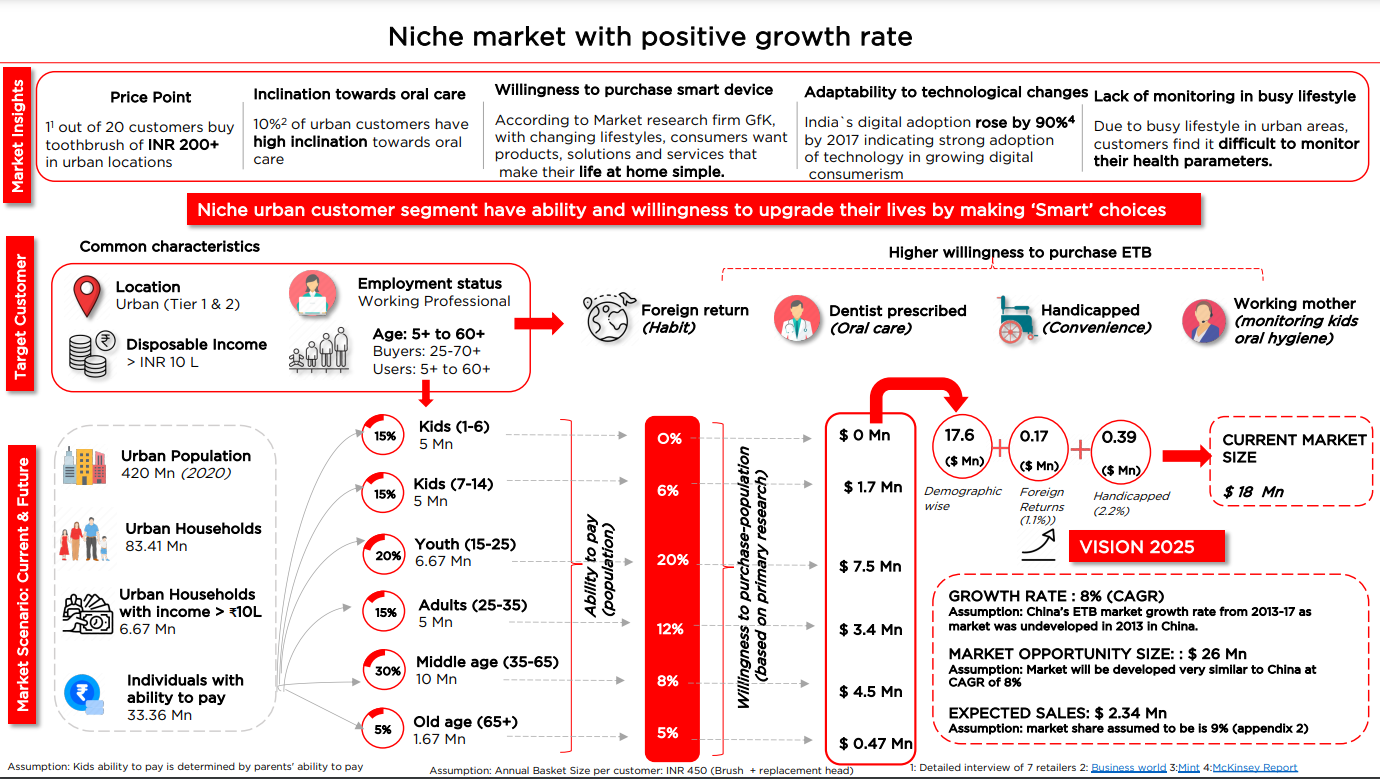
After identifying the problems, we need to establish whether solving them is actually worth it or not. We did this by:
- Expected Sales, Market Size, and Expected Growth Rate of identified customer segment
- Increasing willingness to upgrade life (Market Trend)
- High adaptability to technological changes (Market Trend)

Other methods of identifying problem statements are Focus Groups, Customer Interviews, Journey Analyzers, BCG matrix, Value Chain Analysis, PESTEL, SWOT(W part), Porter's Five Forces, Annual Reports, etc.

Given the short time for case competitions, I think the most efficient method is first-hand experience. Rather than starting from scratch, it is better to identify the problems as a customer and collect more data on the same.
Further, this data can be represented in the form of - Customer Personas, Key Insights, Trends, Customer Decision Making Journey, etc.
If you have identified the right problems, your half work is done!
Before even thinking of solutions, set the KPIs based on the problem statement.
Like, in Accenture Strategy Case Connect, the problem statement was (summary) -
Should a large-scale oil refinery firm diversify into EV charging stations? If yes, suggest an execution strategy
After establishing that the firm needs to diversify, we set the KPI for the solution as - Increment in business generated due to portfolio diversification.

Then, we did a VRIO analysis to identify the competitive advantage (CA), available resources, and capabilities of the firm. SWOT analysis can also be done to get a bird's eye view.
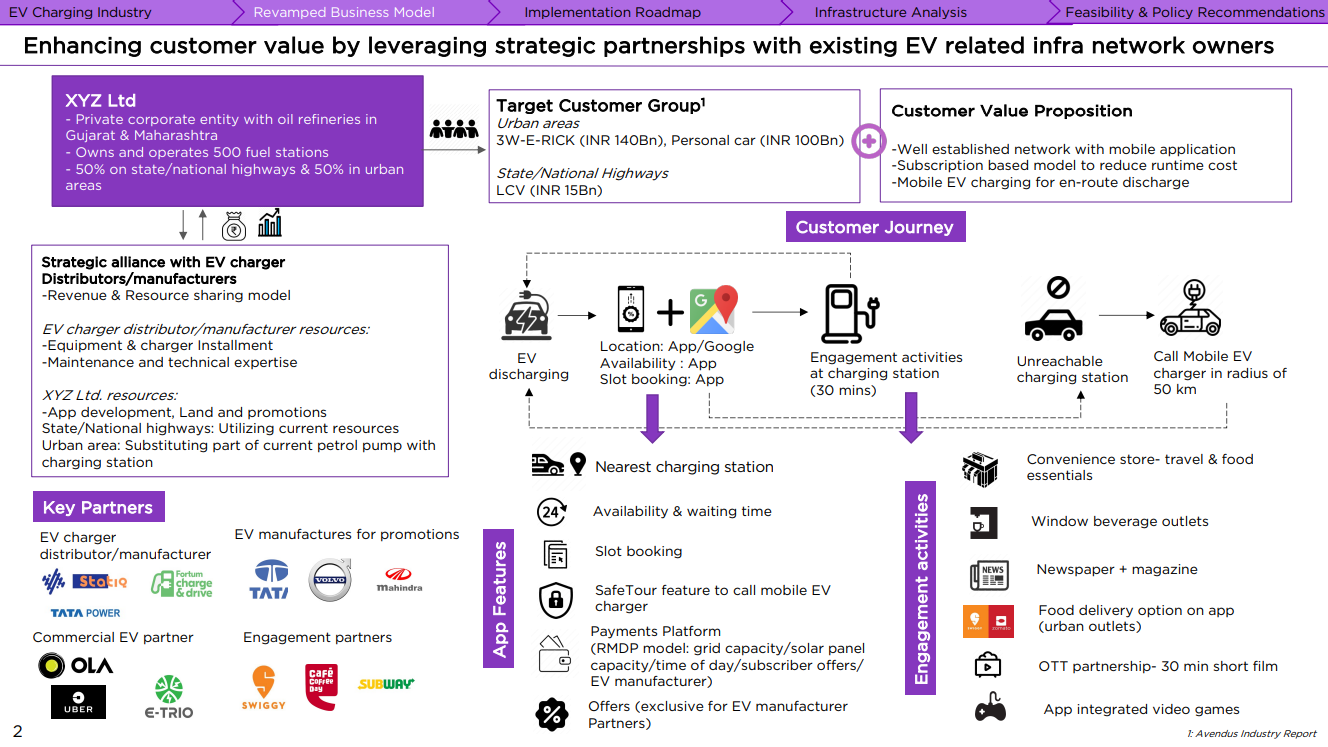
Key insights were:
- The firm has an established infrastructure across the nation (CA)
- The firm is cash-positive (resource)
- Lack of EV charger manufacturing capabilities
Based on the above insights, we decided mode of entry as a strategic alliance with EV charger manufacturers to minimize the entry risk and cost of development.

We represented the solution in the form of a business plan that covered the roles of stakeholders, partners, customer value proposition, and a phase-wise rollout plan for the future.
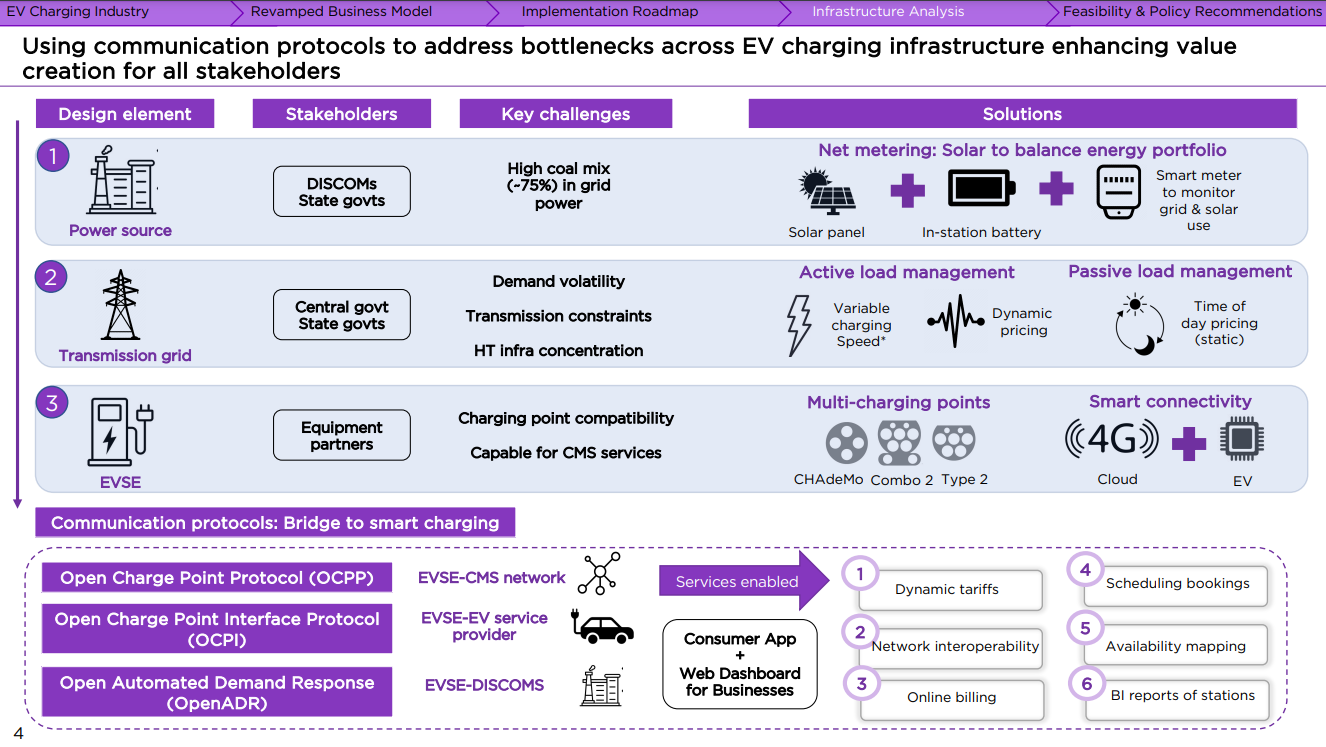
After setting the KPIs and VRIO analysis, in case you struggle to create solutions, you can do:
- Competitor benchmarking to get a reference
- Research strategies implemented by outside-India players
- Study recent technological trends and their application
- Understand the current focus of the firm through annual reports, recent acquisitions, and news headlines
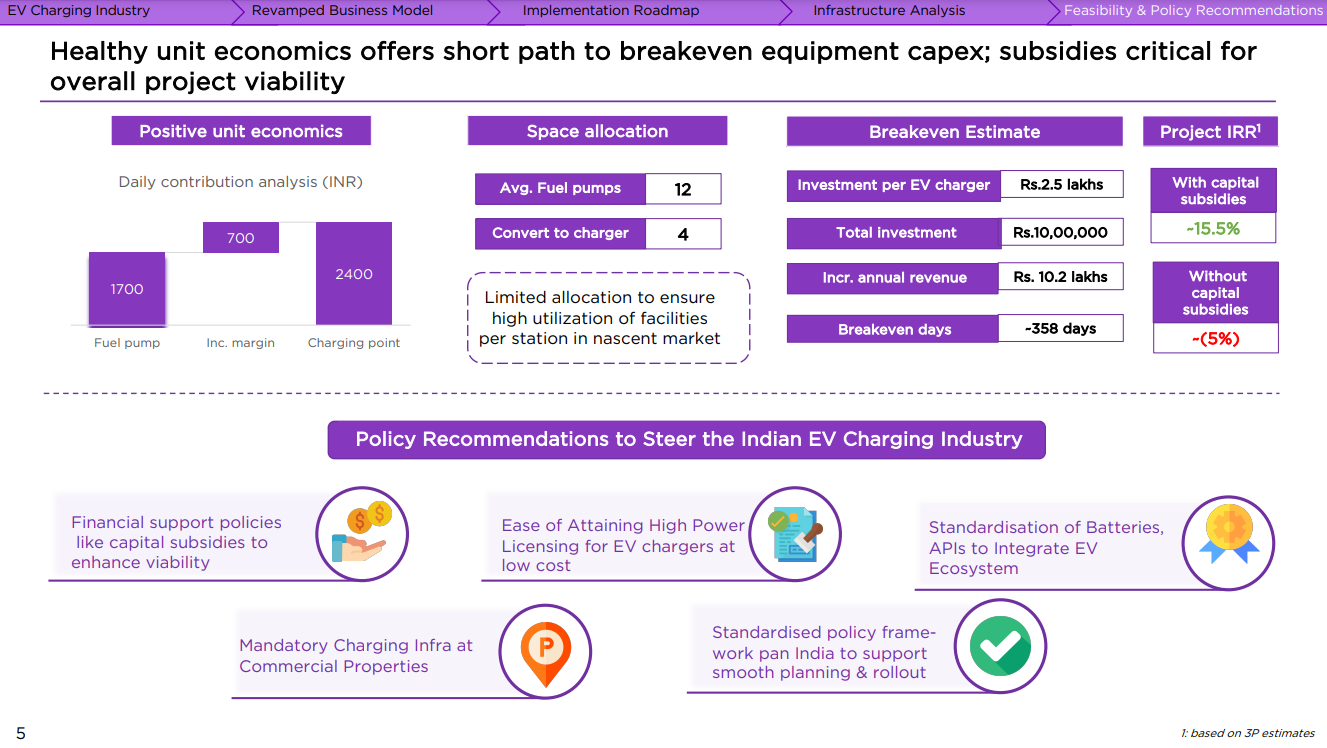
Other ways of representing the strategies are Ansoff Matrix, Portfolio Strategy, Market Mapping, 4Ps, Marketing Funnel, GTM, Mock-ups, etc.
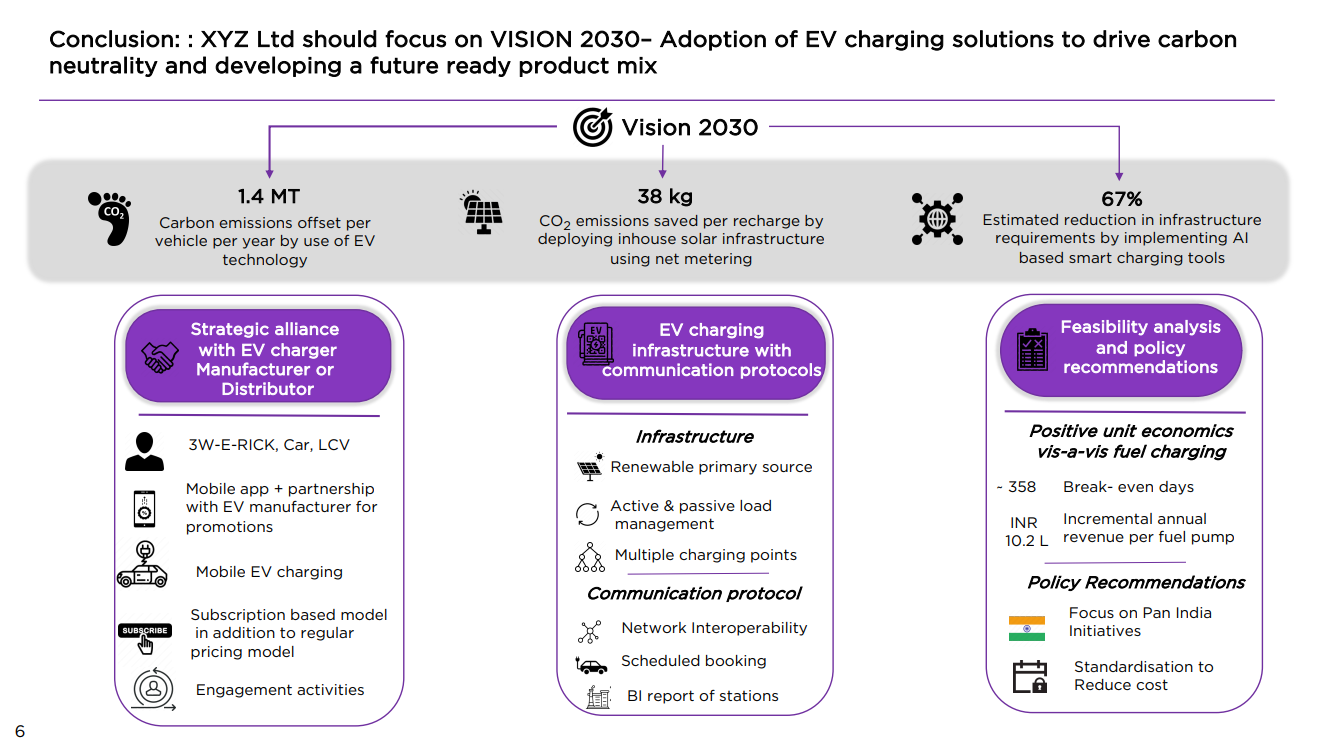
Above all, you should always suggest solutions that reduce customer efforts. If you try changing consumer behavior by increasing efforts, they will exCHANGE you with your competitors.
Competitions like the HCCB Case Challenge provide an exact budget. For others, you must look at financial reports and funding rounds to estimate the budget. Then, you can utilize the data to calculate ROI using guesstimates as accurately as possible (use published data).
You can also do a cost-benefit, NPV- IRR, break-even point, cash-flow analysis, etc. I prefer showing profitable unit economics to envision scale and impact.
In PM/Marketing cases, you can also show whether customers accept the solution or not. If 90% of customers are facing a problem, doesn't mean that 90% will accept your solution.
Like in Myntra Stylbiz, we had to suggest solutions for the 18-25 customer segment such that Myntra becomes the most engaging and preferred destination. We showed results of UAT (using Figma) that indicated the likelihood of customers using the solution. This data also helped to estimate the increase in sales, purchase frequency, and new customers.
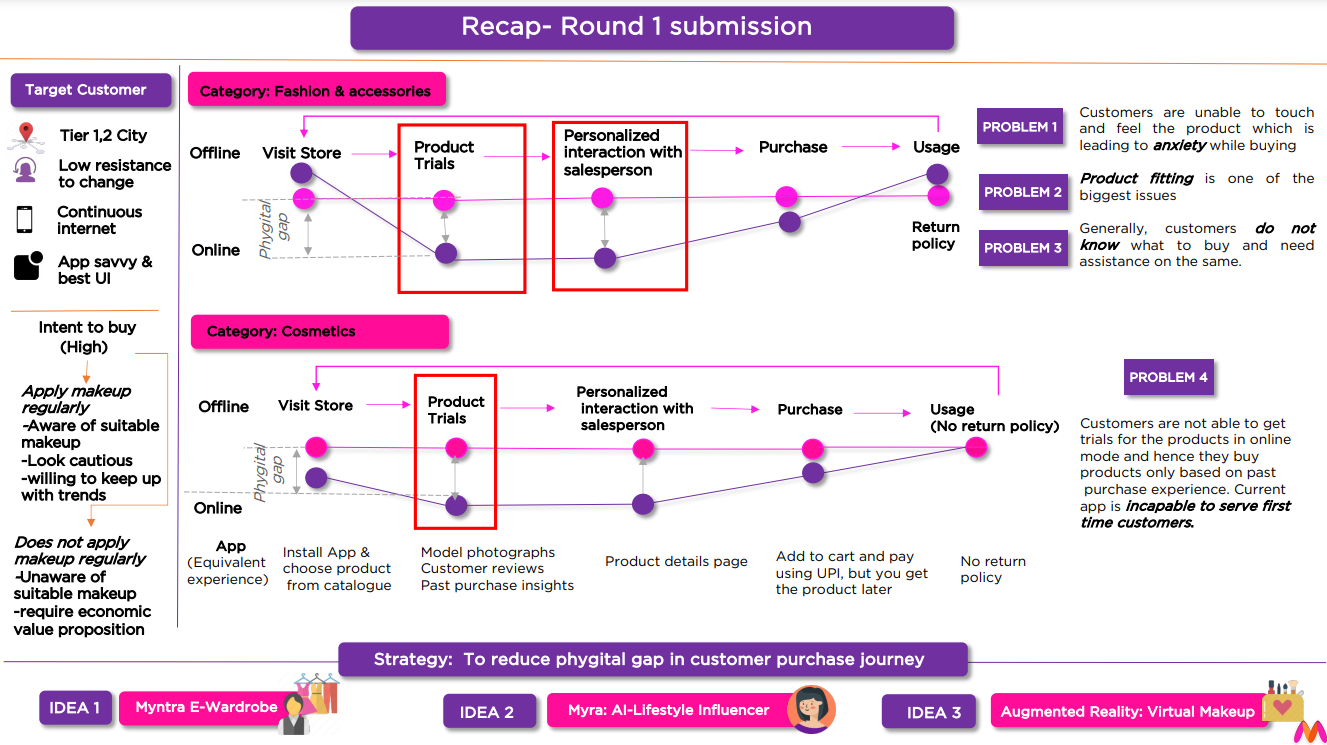
I have also seen participants running marketing campaigns on social media on a small scale.
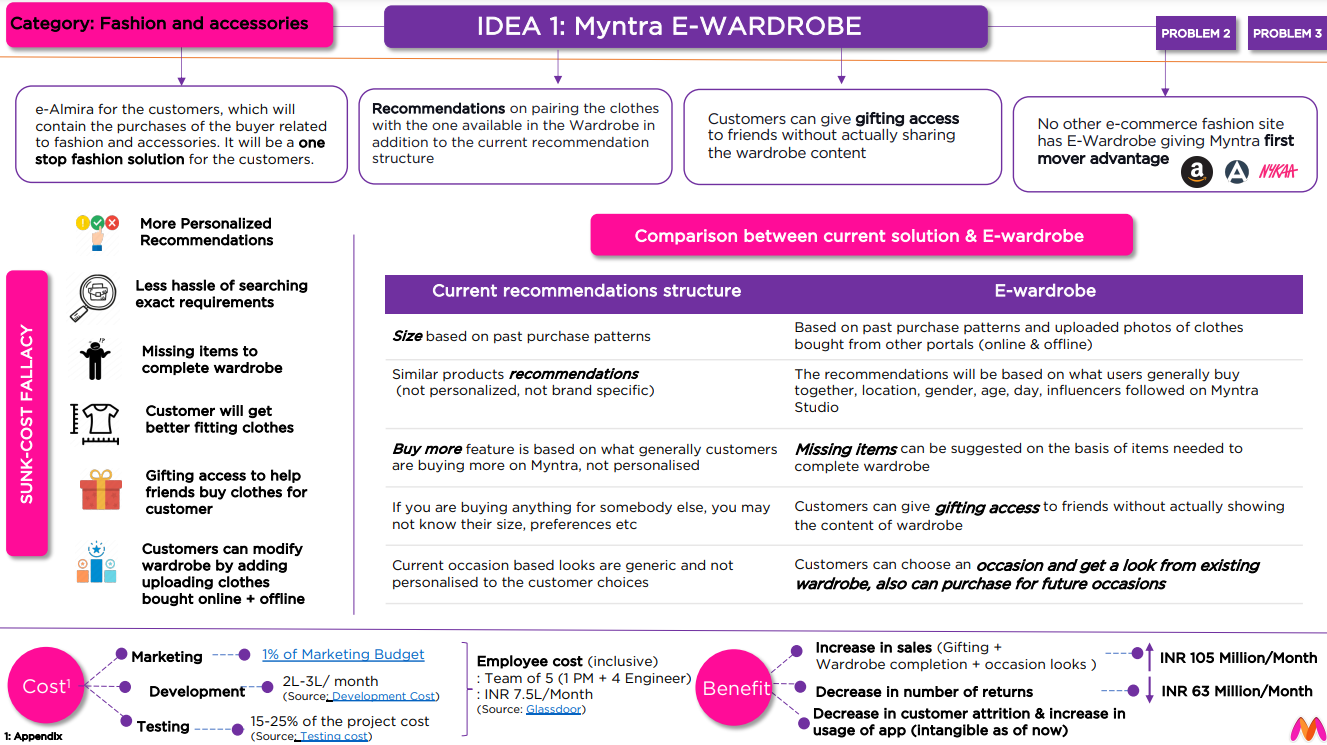
More than thinking big, focus on thinking real.
For more, check out her post.
If you'd like to submit your story, click here .
Whatever your concern, we have broken down everything you need to know about case study competitions , from scratch:
- Challenge Yourself With These B-school Competitions
- Case Study Competitions- Details, Winning Strategies, And More!
- Cheat Sheet To Crack Hiring Challenges And Case Competitions
- How To Win Business Case Competitions: The Secret Revealed
- Why MBA case competitions are worth the hype!

In pursuit of being a good product manager, she started participating in Case Competitions during her MBA. It gave her a mention in Forbes D2C Top 100 Competitive Leaders, but more than that it helped her build problem-solving and team-building skills. It also helped her become insensitive to results, and make a rational sense of them. Apart from PMing, she likes to write, watch movies, crack lame jokes and eat really good food.

to our newsletter
Blogs you need to hog!

L'Oréal Sustainability Challenge 2023 Winners Of Planet Track From BITSoM Dig Out Their Winning Mantra
Hero Campus Challenge S8 Winners Take Us Through Their Road To Victory
TISS HRM & LR Summer Placements 2023: 100% Placement, Record Numbers!
TVS Credit E.P.I.C 5.0 Champions Share Learnings From Their Remarkable Journey!
What is the Case Study Method?

Overview Dropdown up
Overview dropdown down, celebrating 100 years of the case method at hbs.
The 2021-2022 academic year marks the 100-year anniversary of the introduction of the case method at Harvard Business School. Today, the HBS case method is employed in the HBS MBA program, in Executive Education programs, and in dozens of other business schools around the world. As Dean Srikant Datar's says, the case method has withstood the test of time.
Case Discussion Preparation Details Expand All Collapse All
In self-reflection in self-reflection dropdown down, in a small group setting in a small group setting dropdown down, in the classroom in the classroom dropdown down, beyond the classroom beyond the classroom dropdown down, how the case method creates value dropdown up, how the case method creates value dropdown down, in self-reflection, in a small group setting, in the classroom, beyond the classroom.

How Cases Unfold In the Classroom
How cases unfold in the classroom dropdown up, how cases unfold in the classroom dropdown down, preparation guidelines expand all collapse all, read the professor's assignment or discussion questions read the professor's assignment or discussion questions dropdown down, read the first few paragraphs and then skim the case read the first few paragraphs and then skim the case dropdown down, reread the case, underline text, and make margin notes reread the case, underline text, and make margin notes dropdown down, note the key problems on a pad of paper and go through the case again note the key problems on a pad of paper and go through the case again dropdown down, how to prepare for case discussions dropdown up, how to prepare for case discussions dropdown down, read the professor's assignment or discussion questions, read the first few paragraphs and then skim the case, reread the case, underline text, and make margin notes, note the key problems on a pad of paper and go through the case again, case study best practices expand all collapse all, prepare prepare dropdown down, discuss discuss dropdown down, participate participate dropdown down, relate relate dropdown down, apply apply dropdown down, note note dropdown down, understand understand dropdown down, case study best practices dropdown up, case study best practices dropdown down, participate, what can i expect on the first day dropdown down.
Most programs begin with registration, followed by an opening session and a dinner. If your travel plans necessitate late arrival, please be sure to notify us so that alternate registration arrangements can be made for you. Please note the following about registration:
HBS campus programs – Registration takes place in the Chao Center.
India programs – Registration takes place outside the classroom.
Other off-campus programs – Registration takes place in the designated facility.
What happens in class if nobody talks? Dropdown down
Professors are here to push everyone to learn, but not to embarrass anyone. If the class is quiet, they'll often ask a participant with experience in the industry in which the case is set to speak first. This is done well in advance so that person can come to class prepared to share. Trust the process. The more open you are, the more willing you’ll be to engage, and the more alive the classroom will become.
Does everyone take part in "role-playing"? Dropdown down
Professors often encourage participants to take opposing sides and then debate the issues, often taking the perspective of the case protagonists or key decision makers in the case.
View Frequently Asked Questions
Subscribe to Our Emails
- Harvard Business School →
Read posts from
- Author Alumni
- Author Career and Professional Development Staff
- Author HBS Community
- Author HBS Faculty
- Author MBA Admissions
- Author MBA Students
- 1st Year (RC)
- 2+2 Program
- 2nd Year (EC)
- Application Process
- Business & Environment
- Career Change
- Career and Professional Development
- Case Method
- Entrepreneurship
- Financial Aid
- Health Care
- Instagram Takeover
- Letters to Classmates
- MBA/MPP & MBA/MPA-ID
- MS/MBA Biotechnology: Life Sciences
- MS/MBA: Engineering Sciences
- Partners & Families
- Social Enterprise
- Student Life
- Student Loans
- Student Profile
- Sustainability
- Architecture
- Construction
- Consumer Packaged Goods
- Engineering
- Entertainment / Media
- Environment
- Family Business
- Health Care / BioTech
- Manufacturing
- Private Equity
- Real Estate
- Venture Capital
- Diverse Perspectives
- International
- Socioeconomic Inclusion
Geographies
- Middle East and North Africa
- South America
- United States

- 10 Jan 2018
8 Tips to Help You Prepare for the Case Method
Ninad Kulkarni just wrapped up the fall semester at HBS and wanted to share what he learned about the case method after his first few months in the classroom.
You Might Want to Read
- Insights From Harvard Business School’s Peek Program
- College Students, Take a Sneak Peek at the HBS MBA
- Getting a Peek Into the HBS Experience
Admissions Events
Check out our upcoming webinars, prospective student days, and information sessions on campus and around the world.
→ View Events
Recorded Virtual Events
Curious about HBS? We have prospective student virtual events, available by geography, industry and interest.
→ Recorded Virtual Events
Case Study Basics
What is a case study *.
A case study is a snapshot of an organization or an industry wrestling with a dilemma, written to serve a set of pedagogical objectives. Whether raw or cooked , what distinguishes a pedagogical case study from other writing is that it centers on one or more dilemmas. Rather than take in information passively, a case study invites readers to engage the material in the case to solve the problems presented. Whatever the case structure, the best classroom cases all have these attributes: (1)The case discusses issues that allow for a number of different courses of action – the issues discussed are not “no-brainers,” (2) the case makes the management issues as compelling as possible by providing rich background and detail, and (3) the case invites the creative use of analytical management tools.
Case studies are immensely useful as teaching tools and sources of research ideas. They build a reservoir of subject knowledge and help students develop analytical skills. For the faculty, cases provide unparalleled insights into the continually evolving world of management and may inspire further theoretical inquiry.
There are many case formats. A traditional case study presents a management issue or issues calling for resolution and action. It generally breaks off at a decision point with the manager weighing a number of different options. It puts the student in the decision-maker’s shoes and allows the student to understand the stakes involved. In other instances, a case study is more of a forensic exercise. The operations and history of a company or an industry will be presented without reference to a specific dilemma. The instructor will then ask students to comment on how the organization operates, to look for the key success factors, critical relationships, and underlying sources of value. A written case will pre-package appropriate material for students, while an online case may provide a wider variety of topics in a less linear manner.
Choosing Participants for a Case Study
Many organizations cooperate in case studies out of a desire to contribute to management education. They understand the need for management school professors and students to keep current with practice.
Organizations also cooperate in order to gain exposure in management school classrooms. The increased visibility and knowledge about an organization’s operations and culture can lead to subsidiary benefits such as improved recruiting.
Finally, organizations participate because reading a case about their operations and decision making written by a neutral observer can generate useful insights. A case study preserves a moment in time and chronicles an otherwise hidden history. Managers who visit the classroom to view the case discussion generally find the experience invigorating.
The Final Product
Cases are usually written as narratives that take the reader through the events leading to the decision point, including relevant information on the historical, competitive, legal, technical, and political environment facing the organization. A written case study generally runs from 5,000 to 10,000 words of text supplemented with numerous pages of data exhibits. An online raw case may have less original text, but will require students to extract information from multiple original documents, videos of company leaders discussing the challenges, photographs, and links to articles and websites.
The first time a case is taught represents something of a test run. As students react to the material, plan to revise the case to include additional information or to delete data that does not appear useful. If the organization’s managers attend the class, their responses to student comments and questions may suggest some case revisions as well.
The sponsoring professor will generally write a “teaching note” to give other instructors advice on how to structure classroom discussion and useful bits of analysis that can be included to explicate the issues highlighted in the case study.
Finally, one case may inspire another. Either during the case writing process or after a case is done, a second “B” case might be useful to write that outlines what the organization did or that outlines new challenges faced by the organization after the timeframe of the initial case study.
* Portions of this note are adapted from E. Raymond Corey, “Writing Cases and Teaching Notes,” Harvard Business School case 399-077, with updates to reflect Yale School of Management practices for traditional and raw cases.
- PRO Courses Guides New Tech Help Pro Expert Videos About wikiHow Pro Upgrade Sign In
- EDIT Edit this Article
- EXPLORE Tech Help Pro About Us Random Article Quizzes Request a New Article Community Dashboard This Or That Game Popular Categories Arts and Entertainment Artwork Books Movies Computers and Electronics Computers Phone Skills Technology Hacks Health Men's Health Mental Health Women's Health Relationships Dating Love Relationship Issues Hobbies and Crafts Crafts Drawing Games Education & Communication Communication Skills Personal Development Studying Personal Care and Style Fashion Hair Care Personal Hygiene Youth Personal Care School Stuff Dating All Categories Arts and Entertainment Finance and Business Home and Garden Relationship Quizzes Cars & Other Vehicles Food and Entertaining Personal Care and Style Sports and Fitness Computers and Electronics Health Pets and Animals Travel Education & Communication Hobbies and Crafts Philosophy and Religion Work World Family Life Holidays and Traditions Relationships Youth
- Browse Articles
- Learn Something New
- Quizzes Hot
- This Or That Game New
- Train Your Brain
- Explore More
- Support wikiHow
- About wikiHow
- Log in / Sign up
- Education and Communications
How to Write a Management Case Study
Last Updated: December 23, 2023
wikiHow is a “wiki,” similar to Wikipedia, which means that many of our articles are co-written by multiple authors. To create this article, volunteer authors worked to edit and improve it over time. This article has been viewed 140,466 times. Learn more...
A management case study contains a description of real-life management issues and proposed solutions. Students, practitioners and professionals write case studies to thinking critically about issues, and devise and implement remedies for challenging management situations. A case study generally contains facts, theories, assumptions, analysis, and prioritized solutions. The following are the steps for writing a management case study.
Identify the Objective, Method and Facts

- Choose an analytical approach to increase awareness. In the preliminary stages of solving management problems, an analytical case study might best meet the goal of alerting upper management to core facts and issues. An analytical case study primarily focuses on what has occurred and why.
- Select a problem-solving approach to pinpoint and solve major issues. If the goal is to make solution recommendations, write a problem-solving case study that clearly outlines problems and solutions.

Set the Scope for Readers

Focus on Issues and Solutions

- Address the challenges that might accompany suggested solutions. For example, cross-cultural conflicts in an organization might require additional training for managers, which may require funds or an extensive search for topic experts.
Provide a Clear Conclusion

Cite References

Community Q&A
You Might Also Like

- ↑ https://www.wordstream.com/blog/ws/2017/04/03/how-to-write-a-case-study
- ↑ https://libguides.usc.edu/writingguide/assignments/casestudy
- http://monash.edu/lls/llonline/quickrefs/27-case-study.pdf
- http://www.schreyerinstitute.psu.edu/pdf/CaseWritingGuide.pdf
About This Article
To write a management case study, first give a clear industry overview of the problem and explain theories and current knowledge. Next, pinpoint all the important issues and identify any underlying problems. For example, conflicts between team members might stem from unclear workplace policies. Finally, generate effective solutions and explain why they will work. Wrap it up with a conclusion that summarizes the problems and solutions you discussed. Read on for more details on how to conduct research for a management case study and cite your sources. Did this summary help you? Yes No
- Send fan mail to authors
Did this article help you?

Featured Articles

Trending Articles

Watch Articles

- Terms of Use
- Privacy Policy
- Do Not Sell or Share My Info
- Not Selling Info
Get all the best how-tos!
Sign up for wikiHow's weekly email newsletter
- Harvard Case Study Solution
- Case Study Report Writing Service
- Case Study Presentation Help
- Finance Case Study Help
- Accounting Case Study Help
- Marketing Case Study Help
- Nursing Case Study Help
- Management Case Study Help
- Economics Case Study Help
- MBA Case Study Help
- Assignment Help
- Accounting Assignment Help
- Finance Assignment Help
- Marketing Assignment Help
- HR Assignment Help
- Economics Assignment Help
- Law Assignment Help
- Project Management Assignment Help
- Nursing Assignment Help
- Biology Assignment Help
- Chemistry Assignment Help
- English Assignment Help
- Homework Help
- Thesis Help
- Dissertation Help
- How it Works
How To Solve A Case Study
Introduction
What is a case study? A case study is a deep study or a detailed examination of a particular case. In politics case studies, it can range from little happenings to huge undertakings like world wars. It is not necessary that a case study only highlights only an individual’s case but it can also highlight groups, belief systems, organizations, or events. Necessarily the case study does did not include only one observation but it may include many observations. In the case of studies projects for research involving several cases are called cross-case research; on the other hand, the study of a single case is called within the case research.
How to solve a case study?
Solving a case study requires deep analyzing skills, the ability to investigate the current problem, examine the right solution, and using the most supportive and workable evidence. It is necessary to take notes, highlight influential facts, and underline the major problems involved. Into days modern times; you can also online case study solutions help by contacting experts on their websites. To make it easier we follow a step-wise procedure to make it understandable. So before you begin Writing the case, follow the step-by-step procedure to get reasonable and desired results.
Step#1: Identify The Case
The first step is about taking notes, highlight the key factors which are being involved, and also introduce the relevant factors which are necessary.
Step#2: Focus Your Analysis
Identify the key problems. Find the reason that why Do they exist? How can they affect the organization or client? Which thing is responsible, and go for their best possible solutions.
Step#3: Realize Possible Solutions
Review all the reading related to the case study course, related discussions, consult it with outside sources, and utilize your experience.
Step#4: Choose The Best Possible Solution
Consider the best and supporting evidence. Its pros and cons, and how realistic it is?. Scan the gathered information again and do not overlook it without focusing on each point.
This is how to solve a case study step by step and easily conclude it while benefiting your clients following these well-researched steps. Additionally following these steps one can also be familiar that how to write case study assignment while getting less confusion.
Examples OF Solving A Case Study
As we know case study involves examining things deeply; for example, we take a case study in medicines. It may be related to an ailment or a patient; a case study in the business sector might cover a broader market; in politics, a case study might range from a narrow happening to a huge undertaking. Let’s discuss How to solve case studies with examples,
Example#1: AnaOwas a woman’s pseudonym of a lady named Bertha. A patient of a famous physical expert Jose Breuer. She was never a patient of another physician Freud. Both physicians Breuer and Joseph, extensively discuss her case. The woman was expecting the symptoms of a disease known as hysteria and it is also found that talking about her issues relieving her a lot and her symptoms. Her case becomes beneficial to understand the fact that therapy of talking has an excellent approach towards mental health.
Example#2: Phineas Gage was an employee in railways. Phineas experiences a scary accident in which a metal rod stuck his skull, damaging a sensitive portion of his brain; although he recovered after that, he comes up with extreme changes in his behavior and personality.
Example#3: Genie a young beautiful girl faced horrifying abuse and isolation. Genie’s case study allows many researchers to examine whether languages could be learned even after hectic times for developing language had vanished for her. Her case also enables everyone to understand that how interference of scientific researches leads to more abuse of a vulnerable person. One can also consult their mentors to understand which case study to buy and get the valuable guidance.
Benefits and Limitations OF A Case Study
A case study could have both strengths and drawbacks. Here we discuss its good and bad things in the form of bullets. First of all, we get to know about its pros.
- It allows investigators and researchers to attain high-level knowledge.
- Give them a chance to attain valuable information from Unusual and rare cases.
- Allow the individuals for research to develop their hypotheses to explore them at experimental research.
Along with its pros, case studies have their cons too. Let’s discuss them in bullets.
- The case study cannot briefly demonstrate cause and influences.
- It cannot be generalized in public.
- It can also lead to bias.
Bottom Lines
Generally, case studies can be included in many different fields like education, anthropology, psychology, medicines, and political sciences. We have discussed in the article above about case study definition, how to solve it, and also include the examples for your better understanding. Hoping that this article will play its part in building your knowledge about studying a case.
Suggested Articles
How To Answer A Case Study
A Step To Step Guide On The Importance OF Case Study
How To Buy A Case Study Assignment Help
How To Write Case Study In MBA
How To Write A Case Study For Assignment
Table of Contents
How to solve a product manager case study in 4 simple steps.
- August 12, 2020
Richard Chen
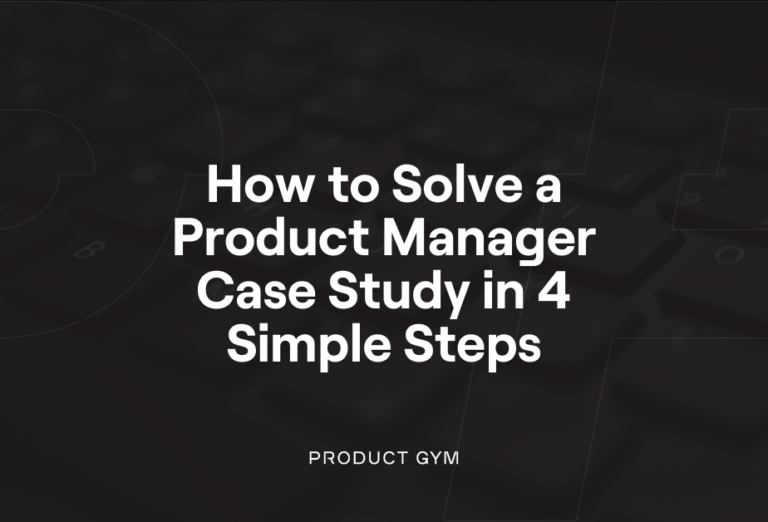
We cannot emphasize the importance of Product Manager case studies in interviews enough. Companies rely heavily on this step to assess your critical thinking and problem-solving skills as it closely mirrors the day-to-day activities. However, you don’t have to be a Product Manager with years of experience to come up with impressive case studies that will get you hired. Like the job itself, a Product Manager case study should be situational and contextual—getting it right is about tailoring your answer to the company you are interviewing for and the context behind the question.
So, how do you make sure you hit the nail on the head? There are four steps to solving the Product Manager case study. Our case study instructors recommend the following:
- Evaluate the need
- Validate the need
- Set a goal for the feature
- Decision making
From startup case studies to whiteboarding questions, this guide will take you through everything you need to know about tackling the notorious product management case study using these simple steps. Practice this approach with the various examples we provide and you should be ready to ace your next Product Manager case study interview .
How to Approach the Product Manager Case Study
Let’s say that an e-commerce furniture company wants to implement a feature: free returns. Take a minute to think about this case study question . How would you go about implementing this? What is your first step?
If there’s one thing we know from working with thousands of aspiring Product Managers, it’s that more than 90% of the candidates fail the product manager case study interview one way or another. And not because the candidates lacked the required skills! Like we mentioned above, a successful case study is tailored to the situation and context.
Before we dive in, here are some pointers you should remember to get you into the right frame of mind as you tackle the case study assignment you are given.
Ask Questions
This is where to start: Always approach a case study assignment with the assumption that you know nothing. Never dive into solving the problem with little to no information on it. Don’t be afraid to ask your interviewer everything you need to:
- Determine the user of the product
- Narrow down and identify which problem to solve
- Find out the specifics of the question to establish your edge cases
Making assumptions could lead you down the wrong path, but on the other hand, remember that being a Product Manager involves solving ambiguous real-life issues. Keep calm and creatively and strategically acquire more information for clarity of the situation. You’ll be one step ahead of fellow candidates.
Prepare for Anything
Many novice candidates believe that the case study round always involves a take-home assignment, which would allow them to do extensive research on the question at hand. But while take-home assignments do come up often enough, unfortunately, that’s not always the case. Prepare for your case study interview to involve on-the-go questions. You should also expect to whiteboard and solve problems on the fly during the interview. When that’s the case you’ll have only seconds — or minutes if you’re lucky — instead of days to tackle the problem.
There Is More Than One Correct Answer
The Product Manager case study interview is a way for companies to evaluate your problem-solving skills. They want to see how you identify product users, measure product performance, navigate technical aspects, and so on. You can demonstrate these competencies with a variety of answers.
Don’t Spend More Time Than You Need To
The take-home Product Manager case study can be especially time-consuming and you might spend all your time working on these assignments if you don’t have support . Remember that job hunting is a numbers game and allocate your time and effort accordingly.
Need more time to prepare for your next case study interview? Take your prep to the next level with this video by Product Gym co-founder Cody Chang:
How to Solve Any Product Manager Case Study in 4 Simple Steps
Without further ado, here are the four steps you need to follow to solve your Product Manager case study:
Step 1: Evaluate the Need
To understand the need in the Product Manager case study, you need to ask a series of questions. Here are a few of them to get you started:
- How did the company come up with this feature?
- Was it suggested by executives, or by customers?
- Is the goal of this feature to drive revenue or increase loyalty?
- Are we assuming that leadership has already signed on board to this feature?
- Or are we assuming that this is just a small product that we have been given to test?
Essentially, you need to figure out the bounds and constraints of this question.
You may not be an industry expert on the business that your interviewer is in, or you may lack that domain knowledge. So in order to create an informed answer, you have to know what your answer is not .
Step 2: Validate the Need
You have to start on the pre-question. Let’s take the example of a furniture e-commerce company.
Some of the questions you would ask yourself are:
- What are your assumptions, knowns and unknowns, and where is the data?
- Do we have data on this, and is the data right?
- On free returns, do we know how many people already trying to return?
- Are there specific types of products that we know customers return?
- Are there some parts of the world where customers expect free returns? Do we have data on that? (The company isn’t going to necessarily know that from the data because customers might not provide that feedback.)
- What do we not know?
When you focus on these unknowns, what you’re really focusing on is time and resources. This gets into the business side of asking questions. If you are not a domain expert in furniture e-commerce or are not familiar with their business model to give a nuanced response, what are these Product Managers looking for in your answer?
The company you are interviewing with is likely operating in another domain that you are not familiar with. That’s okay. As long as you can lay out the roadmap for your product with sound reasoning, you’ll be good to go.
Step 3: Set a Goal for the Feature
In this specific example, you want to focus on time and resources, which is money. This means explicitly profitability . What are all the areas that might factor into profitability? Here are some questions to consider:
- How much is it going to cost, and how do you evaluate that cost?
- Will priorities in regards to other features change?
- Would we have to focus on other resources?
- Would we have to deal with interstate laws based on shipping?
- How about shipping internationally or shipping interstate? Will it be taxed?
Check out these guides to help you determine the essential metrics for your company’s business and the product you are developing:
- 16 Startup Metrics by Adresseen Horowitz
- Startup Metrics You Need to Monitor
- Facebook Metrics: Key Benchmarks for PM Interviews
Step 4: Decision-Making
Based on the business requirements, how do you want to evaluate these unknowns? The rabbit hole of questions can go on and on. You may need to spend these resources and push back the engineering deadline. Is the company okay with that?
It also depends on how you communicate “Yes” or “No” answers. If you say, “Yes, I want to prioritize this feature,” then know your reasons:
- The manager has signed off on the strategy .
- I know who the customers are.
- I have the data to back it up.
- I have the stakeholder consensus to do it.
- I have a timeline that I feel confident executing on.
Or, if you say “No,” have your reasons why to address the same areas:
- No, I don’t have a clear strategy from management.
- No, the manager wants me to validate this before we spend extra resources on it.
- No, we don’t have enough engineers or resources for this.
- No, we have to use the sales cycle for another feature — if we try to implement this now, we will lose the seasonal sales cycle.
These are all moving parts that you want to evaluate and then communicate to the PM interviewing you in the Product Manager case study. The best thing to do when you ask these questions is to get specific. Use examples of times when you had to make these decisions yourself based on these factors.
Remember to communicate competency on how you evaluate whether or not you implement a feature. Ask questions to create constraints and boundaries to the case study, and control its scope. Once you have this information, you will know how to best approach the questions based on the Product Management knowledge you possess.
BONUS Step: Get Your Case Study Presentation Reviewed by a Professional
You’ve worked through the case study and put your solution into a slide deck to present to a panel of interviewers: congratulations! But if you want to go above and beyond to impress the hiring team, take some time to get your case study solution reviewed by a professional.
A fresh set of eyes may catch typos and grammar errors, but will also be able to point out the areas where you can improve the solution overall. A Product Manager who’s gone through multiple case study interview rounds is going to be able to assess your solution from the perspective of the interviewer and use their experience to help you polish it.
At Product Gym, our interview coaches routinely check over members’ case study presentations, offering insight, constructive criticism, and tips on how to make their technical interview round a success. Solving case studies isn’t just a good practice for acing your interview — it’s also an excellent way to develop applicable Product Manager skills. That’s why we include classes on case studies in our program. Our case study curriculum was developed and continues to be taught by Senior Product Manager for Atlassian, Roman Kolosovskiy .
Because we’ve been working with Product Manager job hunters for the past five years, we’ve had ample opportunity to test and perfect the case study strategy we teach our members. We’ve even compiled a bank of case study prompts that aspiring Product Managers have received in their interviews so that members can exclusively access to hone their problem-solving and storytelling skills.
What to Expect from a Product Manager Case Study at a Startup
The type of company you are interviewing for is a key consideration when determining the context for your case study. It’s highly likely that you will interview for a Product Manager position at a startup—there were 30.7 million startups in the US in 2019, and the numbers will only keep growing.
No doubt, the expectations, and responsibilities differ immensely in a startup role as compared to being an enterprise PM.
Here’s what you should keep in mind when interviewing for a PM position with a startup:
- Product Managers are expected to wear multiple hats : Startups, especially early-stage ones, don’t have all the resources they need. Because of this, your responsibilities may include roles away from the standard PM job description. It’s also likely that you will be responsible for more than one product.
- Be ready for some confusion : Many of these companies don’t have a recruiting team or a full-fledged HR strategy, and therefore chances are they are also exploring interviewing as they go.
- Prepare for niche markets : If the startup operates in a niche market, you might have little to no knowledge and resources for understanding the competitive landscape and creating a useful product. Our case study prep guide can help you sound like a seasoned expert no matter your background in such cases.
So how do you show your interviewer that you are ready to take on the challenge?
1. Demonstrate Fast Execution
First and foremost, you should show that you are quick when making decisions and taking action. Unlike established companies, you will not have many tools or practices to help you make decisions and organize your and your team’s tasks. You should be comfortable with communicating decisions and last-minute action items with the rest of your team.
2. Be Ready to Take Risks
Executing decisions takes a sense of responsibility and ownership, which brings us to our second point. As a Product Manager, you should be a leader who isn’t afraid of taking risks. When needed, you should be ready to take the driver’s seat. There is no doubt that your responsibility will exceed a single product, and you will soon be expected to come up with ideas that will impact the whole company.
3. Prove You Can Multitask
Limited resources mean you may find yourself wearing different hats. For example, you might not have a UX designer and end up designing the wireframes yourself. Regardless of the situation, get ready to prove to them that you can multitask. How do you show this skill in your Product Manager case study?
- By thinking about how this company can make money — or in Product Gym terms, by becoming a wartime Product Manager. Think about how the product in question will contribute to the company’s short-term and long-term goals.
- Many startups are still in the funding stage, so any work you design should generate revenue with minimal costs.
- Think about all the ways you can create a product that the market currently needs and lacks.
- Include wireframes in your case study presentation to show them that you already thought about how the product should look.
- In your documentation and presentation, describe the resources you will need and how you budget this product.
4. Learn About the Company
A case study assignment is a simulation of the real job, especially in startup interviews. Leverage it to learn as much about the company as possible. Assess how they treat you and try to figure out how the company culture is.
Are they ignoring your emails and acting like you don’t exist? Or are they making a genuine effort to make the interview work for you despite the lack of resources? Are you expected to solve a complex case study on the go during an interview?
Answering these questions can give you a good feel of your possible future employer.
5. Prioritize, Prioritize, and Prioritize
As we mentioned, startup companies operate with minimal resources and are under a lot of stress. So, remember to focus on the essential features needed to create a fully functional MVP ready for the market in the least amount of time.
Make some realistic estimations and come up with numbers to help your interviewers with the budget, resources, and time you need to create this product. Roadmap the steps required to get to the MVP and clearly define everybody’s responsibilities to build it.
How to Solve Whiteboarding Case Study Questions in 4 Steps
Along with the commonly assigned take-home assignment and the presentation that follows, the product management case study is notorious for its technical and whiteboarding interview questions. Here are four simple steps our instructors developed to help you master the dreaded whiteboarding interview questions in your case study round.
Step 1: Keep Calm and Embrace the Fact that You Know Nothing
Most aspiring PMs fail the Product Manager case study not because they do not have experience, but because they panic over a lack of information.
In practice, Product Managers rarely have enough information about the problem they were asked to solve. Having seen many candidates interview, we can confirm that interviewees often disqualify themselves by showing the interviewer that they are not ready to tackle ambiguous real-life issues.
So, remember to keep calm and accept the fact that you have insufficient information about the problem that’s thrown at you.
Step 2: Try to Understand What the Question Wants You to Achieve
Companies ask whiteboarding interview questions to see if you can create or improve a product that can accomplish a specific goal. When you take on any product management case study question, start by taking a step back. Think about what the question wants you to accomplish.
In most cases, you should be able to divine the purpose of the question from how the interviewer forms it. Our case study instructors have identified four specific purposes:
- Prioritization
- Product Design
- Target Market Identification
- Product Launch
Determining the purpose behind vague questions and finding the right approach to address them requires a lot of focused practice with real case study questions.
Step 3: Nar row Down the Question as Much as Possible
You need to narrow down the case study questions as much as possible to come up with some real and data-driven conclusions. Given that you have little to no resources available to you, you have to make some realistic estimations. Accurate estimations are only possible if you get to the heart of the question.
Think it through and ask as many questions as you need.
Step 4: Keep the Conversation Alive
Communication is an essential part of the case study interview: you should keep your interviewer informed about every aspect of your thought process. After you identify the whiteboarding question’s purpose, clearly inform your interviewer what direction you want to take and your reasoning.
Check your reasoning with your interviewer by asking them if this is something on their mind or if this is something they would consider. In most cases, they would either have an answer key or a direction on their mind and would be able to help you.
Once you agree on the direction you take, ask more specific questions to extract as much information as possible and get a confidence vote from the interviewer that you are on the right track.
Last but not least, make your interviewer’s life easier by suggesting options and giving details while asking questions. See how we used these four steps to work through a Facebook Product Manager Case Study question: Should Facebook enter the dating market?
Product Manager Case Study Presentation Best Practices
You have worked hard and finally finished your Product Manager case study assignment, but that doesn’t mean you can sit back and relax—your case study presentation is as vital as solving the question.
Not only is it the time to demonstrate your excellent communication skills, but a good presentation shows your interviewers how you collaborate. Here’s a breakdown of how to give a winning presentation:
- Design and Brand Your Presentation Materials: The best way to prove that you are a big fan of the company and have the spirit to join the team is to use company colors, logos, and any media related to them. A good design always draws attention, and you want to grab as much attention as you can.
- Have the Right Amount of Content: Have just enough content to ensure that people know enough about your product to be convinced that it has potential. Include all the relevant details about the fundamental aspects of the product. But, leave them curious about the finer details. This will keep them engaged throughout the presentation.
- Include Visuals and Media to Spark Feedback from the Audience: Activating the brain’s visual cortex will keep your interviewers engaged throughout your presentation. The best way to ensure that everybody understands your product is to include wireframes and preliminary designs in your presentation.
- Make Sure Everyone Has a Positive Experience With Your Presentation: A good rule of thumb is to make sure you can explain your product to a five-year-old and a Ph.D. simultaneously. Start simple and allow the audience to ask questions as you progress. Allocate a considerable amount of time to go over your designs and ask the interviewer for feedback: Ask them questions, see what they think, and learn about the things they would have done differently.
- Paint a Clear Picture of the Product With Your Wireframes: When you are sketching wireframes for your product management case study, be sure to include anything you can explain in terms of functionality. Given that many of the products are digital, it’s crucial to explain the transitions between one screen to another. For example, you should explain what happens when a user clicks on something and which screen comes next. If the next screen is an integral part of the feature, you should include it in your case study deliverables.
List of Product Manager Case Study Question Examples
Before we dive into the most common examples of Product Manager case study interview questions , let’s solve one together. Check out how our Case Study Instructor, Roman Kolosovski, tackles the popular FAANG case study question “How would you build a product for pet owners?”:
1. Product Design Case Study Questions
These are the most common types of questions. They range from designing a product from scratch to improving an existing product. Some questions will explicitly tell you to focus on a specific OKR, while others will leave everything ambiguous to challenge you to think more.
Product Design Question Examples
- Design a product to help users find doctors on Facebook .
- How would you improve Google Maps?
- You’re a part of the Google Search webspam team: How would you detect duplicate websites?
- Name any product you love and any product you despise and explain your reasoning for both cases. ( Amazon )
- You’re the Product Manager of a team that focuses on financial products for our Uber drivers. You’re tasked with designing a financial product (or suite of products) that addresses our drivers’ needs in Brazil.
2. Product Strategy Questions
Unlike product design questions, strategy questions require you to think about the bigger picture. You’ll either be asked to find ways to make a product better—and hence define success for the product, or to complete the overall organization more successfully.
To solve these questions, you need to be well informed about the company and its products or services. Consider the company’s business model, competitors, and the recent developments in that industry. The essential skill you need to demonstrate here is analytical thinking.
Product Strategy Question Examples
- If you were Google’s CEO, would you be concerned about Microsoft?
- How would you improve Google Maps? (Google)
- How would you set goals and measure success for Facebook notifications?
- How would you monetize Facebook messenger?
- How would you determine the right price and method to promote product XYZ, and why? (Amazon)
3. Estimation and Analysis Questions
These are used by interviewers to measure how comfortable you are making decisions with limited data, so show them how you use data to derive the KPIs you need for your product. These questions are mostly asked during the interview. To solve them without internet access is only possible by learning the fundamental values of the company beforehand. This includes the revenue it makes or the approximate number of users it has. You should also be able to calculate their critical KPIs.
Estimation and Analysis Case Study Question Examples
- How many queries per second does Gmail get?
- As the Product Manager for Google Glass ‘Enterprise Edition’, which metrics would you track? How do you know if the product is successful?
- How much revenue does YouTube make per day?
- How would you go about estimating the number of gas stations in the USA?
- How would you track user engagement in an app, and what KPIs would you use to improve it?
4. Scheduling/Operational Questions
These types of case study interview questions are few and far between. Interviewers ask these questions to assess the candidates’ ability to turn ideas into deliverable tasks. Note that for most operational Product Manager case study questions, the interviewer will require you to write a detailed delivery schedule and write user stories and tasks.
Scheduling/Operational Case Study Question Examples
- Write the Jira ticket(s) for engineering for the idea you want to execute. (Upwork)
- Outline a brief (1-2 page) launch plan that would cover the activities and tasks needed to launch the feature successfully. Be sure to touch on both internal and external stakeholders, and include potential launch goals. (Stitch Data)
Product Manager Case Study FAQs
The short answer is yes. You should always have a couple of screen designs ready for your case study interview. Why? It’s probably the best way to spark any reaction from the interviewing committee. Plus, it’s also way more comfortable for your audience to understand what your product looks like with a solid prototype.
Given that it’s not your job to develop the actual design, low fidelity seems more appropriate. That being said, the bar for low fidelity designs has been relatively high over the past couple of years. So, low fidelity designs are more than pen and paper sketches: they are expected to be digital.
Detail the solution you came up with a presentation that states: Here is what the solution is. Here is what the solution looks like. Here is how a user would go through the process within this solution.
There are four common types of Product Manager case study questions: Product design questions Product strategy questions Estimation and analysis questions Scheduling/operational questions
Unlike larger companies, startups do not have as many tools and resources at their disposal. This means that not many will have a recruiting team or a full-fledged HR strategy and are interviewing as they go. Many Product Gym members that have taken the startup route have noted how disorganized the Product Manager interview process can get at a startup, so prepare for some confusion. No matter the size of the company, be sure to assess how they treat you and try to figure out how the company culture is in the process.
Put Your Product Manager Case Study Skills to the Test
Put your case study skills to the test with our free online training course. Access to instructor-led whiteboarding sessions with real FAANG interview qu estions to take your prep to the next level.
Don’t forget to call us for free career coaching to learn more about how Product Gym can help you land the Product Manager job of your dreams!

The Only Leading Metric to Measure Product-Market Fit and How to Use It

Microsoft New Grad PM Interview Preparation and Experience: Spring 2022


Types of Product Managers: Which Specialization Will Ignite Your Career?

The One Thing I Wish More Candidates Asked in Their Product Management Interviews
1412 Broadway, New York City, NY, 10018 (800) 978-2719
Notice: We do not currently accept members with Utah residency.
© 2023 ALL RIGHTS RESERVED.
Terms of Service Privacy Policy
How to write a case study — examples, templates, and tools

It’s a marketer’s job to communicate the effectiveness of a product or service to potential and current customers to convince them to buy and keep business moving. One of the best methods for doing this is to share success stories that are relatable to prospects and customers based on their pain points, experiences, and overall needs.
That’s where case studies come in. Case studies are an essential part of a content marketing plan. These in-depth stories of customer experiences are some of the most effective at demonstrating the value of a product or service. Yet many marketers don’t use them, whether because of their regimented formats or the process of customer involvement and approval.
A case study is a powerful tool for showcasing your hard work and the success your customer achieved. But writing a great case study can be difficult if you’ve never done it before or if it’s been a while. This guide will show you how to write an effective case study and provide real-world examples and templates that will keep readers engaged and support your business.
In this article, you’ll learn:
What is a case study?
How to write a case study, case study templates, case study examples, case study tools.
A case study is the detailed story of a customer’s experience with a product or service that demonstrates their success and often includes measurable outcomes. Case studies are used in a range of fields and for various reasons, from business to academic research. They’re especially impactful in marketing as brands work to convince and convert consumers with relatable, real-world stories of actual customer experiences.
The best case studies tell the story of a customer’s success, including the steps they took, the results they achieved, and the support they received from a brand along the way. To write a great case study, you need to:
- Celebrate the customer and make them — not a product or service — the star of the story.
- Craft the story with specific audiences or target segments in mind so that the story of one customer will be viewed as relatable and actionable for another customer.
- Write copy that is easy to read and engaging so that readers will gain the insights and messages intended.
- Follow a standardized format that includes all of the essentials a potential customer would find interesting and useful.
- Support all of the claims for success made in the story with data in the forms of hard numbers and customer statements.
Case studies are a type of review but more in depth, aiming to show — rather than just tell — the positive experiences that customers have with a brand. Notably, 89% of consumers read reviews before deciding to buy, and 79% view case study content as part of their purchasing process. When it comes to B2B sales, 52% of buyers rank case studies as an important part of their evaluation process.
Telling a brand story through the experience of a tried-and-true customer matters. The story is relatable to potential new customers as they imagine themselves in the shoes of the company or individual featured in the case study. Showcasing previous customers can help new ones see themselves engaging with your brand in the ways that are most meaningful to them.
Besides sharing the perspective of another customer, case studies stand out from other content marketing forms because they are based on evidence. Whether pulling from client testimonials or data-driven results, case studies tend to have more impact on new business because the story contains information that is both objective (data) and subjective (customer experience) — and the brand doesn’t sound too self-promotional.

Case studies are unique in that there’s a fairly standardized format for telling a customer’s story. But that doesn’t mean there isn’t room for creativity. It’s all about making sure that teams are clear on the goals for the case study — along with strategies for supporting content and channels — and understanding how the story fits within the framework of the company’s overall marketing goals.
Here are the basic steps to writing a good case study.
1. Identify your goal
Start by defining exactly who your case study will be designed to help. Case studies are about specific instances where a company works with a customer to achieve a goal. Identify which customers are likely to have these goals, as well as other needs the story should cover to appeal to them.
The answer is often found in one of the buyer personas that have been constructed as part of your larger marketing strategy. This can include anything from new leads generated by the marketing team to long-term customers that are being pressed for cross-sell opportunities. In all of these cases, demonstrating value through a relatable customer success story can be part of the solution to conversion.
2. Choose your client or subject
Who you highlight matters. Case studies tie brands together that might otherwise not cross paths. A writer will want to ensure that the highlighted customer aligns with their own company’s brand identity and offerings. Look for a customer with positive name recognition who has had great success with a product or service and is willing to be an advocate.
The client should also match up with the identified target audience. Whichever company or individual is selected should be a reflection of other potential customers who can see themselves in similar circumstances, having the same problems and possible solutions.
Some of the most compelling case studies feature customers who:
- Switch from one product or service to another while naming competitors that missed the mark.
- Experience measurable results that are relatable to others in a specific industry.
- Represent well-known brands and recognizable names that are likely to compel action.
- Advocate for a product or service as a champion and are well-versed in its advantages.
Whoever or whatever customer is selected, marketers must ensure they have the permission of the company involved before getting started. Some brands have strict review and approval procedures for any official marketing or promotional materials that include their name. Acquiring those approvals in advance will prevent any miscommunication or wasted effort if there is an issue with their legal or compliance teams.
3. Conduct research and compile data
Substantiating the claims made in a case study — either by the marketing team or customers themselves — adds validity to the story. To do this, include data and feedback from the client that defines what success looks like. This can be anything from demonstrating return on investment (ROI) to a specific metric the customer was striving to improve. Case studies should prove how an outcome was achieved and show tangible results that indicate to the customer that your solution is the right one.
This step could also include customer interviews. Make sure that the people being interviewed are key stakeholders in the purchase decision or deployment and use of the product or service that is being highlighted. Content writers should work off a set list of questions prepared in advance. It can be helpful to share these with the interviewees beforehand so they have time to consider and craft their responses. One of the best interview tactics to keep in mind is to ask questions where yes and no are not natural answers. This way, your subject will provide more open-ended responses that produce more meaningful content.
4. Choose the right format
There are a number of different ways to format a case study. Depending on what you hope to achieve, one style will be better than another. However, there are some common elements to include, such as:
- An engaging headline
- A subject and customer introduction
- The unique challenge or challenges the customer faced
- The solution the customer used to solve the problem
- The results achieved
- Data and statistics to back up claims of success
- A strong call to action (CTA) to engage with the vendor
It’s also important to note that while case studies are traditionally written as stories, they don’t have to be in a written format. Some companies choose to get more creative with their case studies and produce multimedia content, depending on their audience and objectives. Case study formats can include traditional print stories, interactive web or social content, data-heavy infographics, professionally shot videos, podcasts, and more.
5. Write your case study
We’ll go into more detail later about how exactly to write a case study, including templates and examples. Generally speaking, though, there are a few things to keep in mind when writing your case study.
- Be clear and concise. Readers want to get to the point of the story quickly and easily, and they’ll be looking to see themselves reflected in the story right from the start.
- Provide a big picture. Always make sure to explain who the client is, their goals, and how they achieved success in a short introduction to engage the reader.
- Construct a clear narrative. Stick to the story from the perspective of the customer and what they needed to solve instead of just listing product features or benefits.
- Leverage graphics. Incorporating infographics, charts, and sidebars can be a more engaging and eye-catching way to share key statistics and data in readable ways.
- Offer the right amount of detail. Most case studies are one or two pages with clear sections that a reader can skim to find the information most important to them.
- Include data to support claims. Show real results — both facts and figures and customer quotes — to demonstrate credibility and prove the solution works.
6. Promote your story
Marketers have a number of options for distribution of a freshly minted case study. Many brands choose to publish case studies on their website and post them on social media. This can help support SEO and organic content strategies while also boosting company credibility and trust as visitors see that other businesses have used the product or service.
Marketers are always looking for quality content they can use for lead generation. Consider offering a case study as gated content behind a form on a landing page or as an offer in an email message. One great way to do this is to summarize the content and tease the full story available for download after the user takes an action.
Sales teams can also leverage case studies, so be sure they are aware that the assets exist once they’re published. Especially when it comes to larger B2B sales, companies often ask for examples of similar customer challenges that have been solved.
Now that you’ve learned a bit about case studies and what they should include, you may be wondering how to start creating great customer story content. Here are a couple of templates you can use to structure your case study.
Template 1 — Challenge-solution-result format
- Start with an engaging title. This should be fewer than 70 characters long for SEO best practices. One of the best ways to approach the title is to include the customer’s name and a hint at the challenge they overcame in the end.
- Create an introduction. Lead with an explanation as to who the customer is, the need they had, and the opportunity they found with a specific product or solution. Writers can also suggest the success the customer experienced with the solution they chose.
- Present the challenge. This should be several paragraphs long and explain the problem the customer faced and the issues they were trying to solve. Details should tie into the company’s products and services naturally. This section needs to be the most relatable to the reader so they can picture themselves in a similar situation.
- Share the solution. Explain which product or service offered was the ideal fit for the customer and why. Feel free to delve into their experience setting up, purchasing, and onboarding the solution.
- Explain the results. Demonstrate the impact of the solution they chose by backing up their positive experience with data. Fill in with customer quotes and tangible, measurable results that show the effect of their choice.
- Ask for action. Include a CTA at the end of the case study that invites readers to reach out for more information, try a demo, or learn more — to nurture them further in the marketing pipeline. What you ask of the reader should tie directly into the goals that were established for the case study in the first place.
Template 2 — Data-driven format
- Start with an engaging title. Be sure to include a statistic or data point in the first 70 characters. Again, it’s best to include the customer’s name as part of the title.
- Create an overview. Share the customer’s background and a short version of the challenge they faced. Present the reason a particular product or service was chosen, and feel free to include quotes from the customer about their selection process.
- Present data point 1. Isolate the first metric that the customer used to define success and explain how the product or solution helped to achieve this goal. Provide data points and quotes to substantiate the claim that success was achieved.
- Present data point 2. Isolate the second metric that the customer used to define success and explain what the product or solution did to achieve this goal. Provide data points and quotes to substantiate the claim that success was achieved.
- Present data point 3. Isolate the final metric that the customer used to define success and explain what the product or solution did to achieve this goal. Provide data points and quotes to substantiate the claim that success was achieved.
- Summarize the results. Reiterate the fact that the customer was able to achieve success thanks to a specific product or service. Include quotes and statements that reflect customer satisfaction and suggest they plan to continue using the solution.
- Ask for action. Include a CTA at the end of the case study that asks readers to reach out for more information, try a demo, or learn more — to further nurture them in the marketing pipeline. Again, remember that this is where marketers can look to convert their content into action with the customer.
While templates are helpful, seeing a case study in action can also be a great way to learn. Here are some examples of how Adobe customers have experienced success.
Juniper Networks
One example is the Adobe and Juniper Networks case study , which puts the reader in the customer’s shoes. The beginning of the story quickly orients the reader so that they know exactly who the article is about and what they were trying to achieve. Solutions are outlined in a way that shows Adobe Experience Manager is the best choice and a natural fit for the customer. Along the way, quotes from the client are incorporated to help add validity to the statements. The results in the case study are conveyed with clear evidence of scale and volume using tangible data.

The story of Lenovo’s journey with Adobe is one that spans years of planning, implementation, and rollout. The Lenovo case study does a great job of consolidating all of this into a relatable journey that other enterprise organizations can see themselves taking, despite the project size. This case study also features descriptive headers and compelling visual elements that engage the reader and strengthen the content.
Tata Consulting
When it comes to using data to show customer results, this case study does an excellent job of conveying details and numbers in an easy-to-digest manner. Bullet points at the start break up the content while also helping the reader understand exactly what the case study will be about. Tata Consulting used Adobe to deliver elevated, engaging content experiences for a large telecommunications client of its own — an objective that’s relatable for a lot of companies.
Case studies are a vital tool for any marketing team as they enable you to demonstrate the value of your company’s products and services to others. They help marketers do their job and add credibility to a brand trying to promote its solutions by using the experiences and stories of real customers.
When you’re ready to get started with a case study:
- Think about a few goals you’d like to accomplish with your content.
- Make a list of successful clients that would be strong candidates for a case study.
- Reach out to the client to get their approval and conduct an interview.
- Gather the data to present an engaging and effective customer story.
Adobe can help
There are several Adobe products that can help you craft compelling case studies. Adobe Experience Platform helps you collect data and deliver great customer experiences across every channel. Once you’ve created your case studies, Experience Platform will help you deliver the right information to the right customer at the right time for maximum impact.
To learn more, watch the Adobe Experience Platform story .
Keep in mind that the best case studies are backed by data. That’s where Adobe Real-Time Customer Data Platform and Adobe Analytics come into play. With Real-Time CDP, you can gather the data you need to build a great case study and target specific customers to deliver the content to the right audience at the perfect moment.
Watch the Real-Time CDP overview video to learn more.
Finally, Adobe Analytics turns real-time data into real-time insights. It helps your business collect and synthesize data from multiple platforms to make more informed decisions and create the best case study possible.
Request a demo to learn more about Adobe Analytics.
https://business.adobe.com/blog/perspectives/b2b-ecommerce-10-case-studies-inspire-you
https://business.adobe.com/blog/basics/business-case
https://business.adobe.com/blog/basics/what-is-real-time-analytics
- Browse Topics
- Executive Committee
- Affiliated Faculty
- Harvard Negotiation Project
- Great Negotiator
- American Secretaries of State Project
- Awards, Grants, and Fellowships
- Negotiation Programs
- Mediation Programs
- One-Day Programs
- In-House Training and Custom Programs
- In-Person Programs
- Online Programs
- Advanced Materials Search
- Contact Information
- The Teaching Negotiation Resource Center Policies
- Frequently Asked Questions
- Negotiation Journal
- Harvard Negotiation Law Review
- Working Conference on AI, Technology, and Negotiation
- Free Reports and Program Guides
Free Videos
- Upcoming Events
- Past Events
- Event Series
- Our Mission
- Keyword Index
PON – Program on Negotiation at Harvard Law School - https://www.pon.harvard.edu
Team-Building Strategies: Building a Winning Team for Your Organization

Discover how to build a winning team and boost your business negotiation results in this free special report, Team Building Strategies for Your Organization, from Harvard Law School.
Case Study of Conflict Management: To Resolve Disputes and Manage Conflicts, Assume a Neutral 3rd Party Role
Here is a case study of conflict management emphasizing the importance of hearing all sides in a dispute.
By PON Staff — on January 11th, 2024 / Conflict Resolution
In their book Difficult Conversations: How to Discuss What Matters Most (Penguin Putnam, 2000), authors Douglas Stone , Bruce Patton , and Sheila Heen tell us how to engage in the conversations in our professional or personal lives that make us uncomfortable by examining a case study of conflict management. Tough, honest conversations are critical for managers, whether they need to change the group culture, manage conflict within a team, give a negative performance evaluation, disagree with others in a group, or offer an apology.
To set the stage for a productive discussion, open a difficult conversation with the “Third Story,” advise the authors of Difficult Conversations . The Third Story is one an impartial observer, such as a mediator, would tell; it’s a version of events both sides can agree on. “The key is learning to describe the gap—or difference—between your story and the other person’s story. Whatever else you may think and feel, you can at least agree that you and the other person see things differently,” Stone, Patton, and Heen write.

Claim your FREE copy: The New Conflict Management
In our FREE special report from the Program on Negotiation at Harvard Law School - The New Conflict Management: Effective Conflict Resolution Strategies to Avoid Litigation – renowned negotiation experts uncover unconventional approaches to conflict management that can turn adversaries into partners.
Suppose two regional sales reps share responsibility for sending weekly updates to their manager. Brad always submits them on time, but Frank often turns them in late. Saying, “Frank, you’ve turned in the sales reports late again” would only put Frank on the defensive. Instead, Brad opens the conversation this way: “Frank, you and I place a different value on deadlines. I want to explain why meeting them is important to me, and then I’d like to hear your take on them.”
Brad learns that Frank, when faced with the choice of possibly making a sale or compiling the report, thinks he should focus on the sale. With this insight, Brad proposes another way to share responsibilities: Brad will complete the report when it’s Frank’s turn to do so, as long as Frank gives Brad two hours’ notice and a share in any commission Frank earns as a result of being able to continue pursuing a lead.
What are your favorite conflict management methods?
Related Conflict Resolution Article: Conflict Management Skills When Dealing with an Angry Public – Here is some negotiation advice drawn from a case study of conflict management dealing with an angry public.
Adapted from “How to Say What Matters Most,” by Susan Hackley (former managing director, Program on Negotiation), first published in the Negotiation newsletter.
Originally published in 2010.
Related Posts
- Advanced Negotiation Strategies and Concepts: Hostage Negotiation Tips for Business Negotiators
- Negotiating the Good Friday Agreement
- Communication and Conflict Management: Responding to Tough Questions
- How to Maintain Your Power While Engaging in Conflict Resolution
- Conflict-Management Styles: Pitfalls and Best Practices
Click here to cancel reply.
Leave a Reply Cancel reply
Your email address will not be published. Required fields are marked *
Save my name, email, and website in this browser for the next time I comment.
Negotiation and Leadership
- Learn More about Negotiation and Leadership

NEGOTIATION MASTER CLASS
- Learn More about Harvard Negotiation Master Class

Negotiation Essentials Online
- Learn More about Negotiation Essentials Online

Beyond the Back Table: Working with People and Organizations to Get to Yes
- Download Program Guide: March 2024
- Register Online: March 2024
- Learn More about Beyond the Back Table

Select Your Free Special Report
- Negotiation and Leadership Fall 2024 Program Guide
- Negotiation Essentials Online (NEO) Spring 2024 Program Guide
- Beyond the Back Table Spring 2024 Program Guide
- Negotiation Master Class May 2024 Program Guide
- Negotiation and Leadership Spring 2024 Program Guide
- Make the Most of Online Negotiations
- Managing Multiparty Negotiations
- Getting the Deal Done
- Salary Negotiation: How to Negotiate Salary: Learn the Best Techniques to Help You Manage the Most Difficult Salary Negotiations and What You Need to Know When Asking for a Raise
- Overcoming Cultural Barriers in Negotiation: Cross Cultural Communication Techniques and Negotiation Skills From International Business and Diplomacy
Teaching Negotiation Resource Center
- Teaching Materials and Publications
Stay Connected to PON
Preparing for negotiation.
Understanding how to arrange the meeting space is a key aspect of preparing for negotiation. In this video, Professor Guhan Subramanian discusses a real world example of how seating arrangements can influence a negotiator’s success. This discussion was held at the 3 day executive education workshop for senior executives at the Program on Negotiation at Harvard Law School.
Guhan Subramanian is the Professor of Law and Business at the Harvard Law School and Professor of Business Law at the Harvard Business School.
Articles & Insights
- Negotiation Examples: How Crisis Negotiators Use Text Messaging
- For Sellers, The Anchoring Effects of a Hidden Price Can Offer Advantages
- BATNA Examples—and What You Can Learn from Them
- Taylor Swift: Negotiation Mastermind?
- Power and Negotiation: Advice on First Offers
- How to Deal with Cultural Differences in Negotiation
- Dear Negotiation Coach: Coping with a Change-of-Control Provision
- The Importance of Negotiation in Business and Your Career
- Negotiation in Business: Starbucks and Kraft’s Coffee Conflict
- Negotiation Examples in Real Life: Buying a Home
- Negotiating Change During the Covid-19 Pandemic
- AI Negotiation in the News
- Crisis Communication Examples: What’s So Funny?
- Crisis Negotiation Skills: The Hostage Negotiator’s Drill
- Police Negotiation Techniques from the NYPD Crisis Negotiations Team
- Managing Difficult Employees, and Those Who Just Seem Difficult
- How to Deal with Difficult Customers
- Negotiating with Difficult Personalities and “Dark” Personality Traits
- Consensus-Building Techniques
- Ethics in Negotiations: How to Deal with Deception at the Bargaining Table
- Perspective Taking and Empathy in Business Negotiations
- Dealmaking and the Anchoring Effect in Negotiations
- Negotiating Skills: Learn How to Build Trust at the Negotiation Table
- How to Counter Offer Successfully With a Strong Rationale
- Negotiation Techniques: The First Offer Dilemma in Negotiations
- Alternative Dispute Resolution Examples: Restorative Justice
- Choose the Right Dispute Resolution Process
- Union Strikes and Dispute Resolution Strategies
- What Is an Umbrella Agreement?
- What is Dispute System Design?
- Overcoming Cultural Barriers in Negotiations and the Importance of Communication in International Business Deals
- Managing Cultural Differences in Negotiation
- Top 10 International Business Negotiation Case Studies
- Hard Bargaining in Negotiation
- Prompting Peace Negotiations
- Advantages and Disadvantages of Leadership Styles: Uncovering Bias and Generating Mutual Gains
- The Contingency Theory of Leadership: A Focus on Fit
- Servant Leadership and Warren Buffett’s Giving Pledge
- How to Negotiate in Cross-Cultural Situations
- Counteracting Negotiation Biases Like Race and Gender in the Workplace
- What Makes a Good Mediator?
- Why is Negotiation Important: Mediation in Transactional Negotiations
- The Mediation Process and Dispute Resolution
- Negotiations and Logrolling: Discover Opportunities to Generate Mutual Gains
- How Mediation Can Help Resolve Pro Sports Disputes
- Identify Your Negotiation Style: Advanced Negotiation Strategies and Concepts
- How to Negotiate via Text Message
- 5 Types of Negotiation Skills
- 5 Tips for Improving Your Negotiation Skills
- 10 Negotiation Failures
- Negotiation Journal celebrates 40th anniversary, new publisher, and diamond open access in 2024
- Ethics and Negotiation: 5 Principles of Negotiation to Boost Your Bargaining Skills in Business Situations
- 10 Negotiation Training Skills Every Organization Needs
- Trust in Negotiation: Does Gender Matter?
- Use a Negotiation Preparation Worksheet for Continuous Improvement
- How to Negotiate a Higher Salary
- Renegotiate Salary to Your Advantage
- How to Counter a Job Offer: Avoid Common Mistakes
- Salary Negotiation: How to Ask for a Higher Salary
- How to Ask for a Salary Increase
- Teach Your Students to Negotiate Cross-Border Water Conflicts
- Asynchronous Learning: Negotiation Exercises to Keep Students Engaged Outside the Classroom
- Planning for Cyber Defense of Critical Urban Infrastructure
- New Simulation: Negotiating a Management Crisis
- New Great Negotiator Case and Video: Christiana Figueres, former UNFCCC Executive Secretary
- How to Win at Win-Win Negotiation
- Labor Negotiation Strategies
- How to Create Win-Win Situations
- For NFL Players, a Win-Win Negotiation Contract Only in Retrospect?
- Win-Lose Negotiation Examples
PON Publications
- Negotiation Data Repository (NDR)
- New Frontiers, New Roleplays: Next Generation Teaching and Training
- Negotiating Transboundary Water Agreements
- Learning from Practice to Teach for Practice—Reflections From a Novel Training Series for International Climate Negotiators
- Insights From PON’s Great Negotiators and the American Secretaries of State Program
- Gender and Privilege in Negotiation
Remember Me This setting should only be used on your home or work computer.
Lost your password? Create a new password of your choice.
Copyright © 2024 Negotiation Daily. All rights reserved.

- Testimonial
- Web Stories
Learning Home

Not Now! Will rate later

MBA Case Studies - Solved Examples

Need of MBA Case Studies
Case i: chemco case.
- ChemCo is a quality leader in the U.K. car batteries market.
- Customer battery purchases in the automobile market are highly seasonal.
- The fork-lift business was added to utilize idle capacity during periods of inactivity.
- This is a low-growth industry (1% annual growth over the last two years)
- Large customers are sophisticated and buy based on price and quality. Smaller customers buy solely on price.
- There is a Spanish competitor in the market who offers low priced batteries of inferior quality.
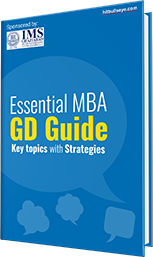
Essential MBA GD Guide: Key Topics with Strategies Free
- Importance of Group Discussions
- Tips and Strategies to handle a GD
- Top 25 GD topics
- Free Download
- Established player in car batteries
- Losing heavily in fork-lift truck batteries
- Old fashioned owner resistance to change
- Low priced competitors
- Foreign competitors gaining market share
- Decisive Interview, GD & Essay prep
- GD: Topics 2021
- GD: Approach
- GD: Do's and Don'ts
- GD: Communications
- Solved GDs Topics
GD Introduction
- Types of GD topics: Techniques
- GD: Ettiquette
- GD: Content
- Solved Case Studies
- High quality product, but low end customers care more about price than quality
- Mismanaged product diversification in a price sensitive market
- Alternative 1: Establish an Off-Brand for the fork-lift business
- Alternative 2: Educate the customer market about product quality
- Alternative 3: Exit the fork-lift battery business
- Establishing the firm's quality image
- Increase in market share
- Increase in sales
- Cost of the product
- Protect firm's quality image in the automobile industry
- Redesigned product to reduce the cost of manufacture
- Low price to enable it to compete with Spanish producer
- Make use of the quality leadership in car batteries market
- Offer reliability testing, extended warranties etc. to promote quality image
- Set higher prices to extract surplus from these advantages
- A passive strategy, not proactive
- Recommendations: Alternative 1 is recommended in this case. Since the firm operates in an industry which has low growth, hence it can expand market share and sales only by taking the customers from other players. Hence, it needs to tackle the Spanish competitor head-on by aggressively pricing its product. At the same time, launching a low-priced product under the same brand name erodes the high quality image in the car batteries market. Hence, the best option is to go for an off-brand to target the fork-lift customers who are increasingly becoming price sensitive. This will enable the company to ward off the threat in short-term and build its position strongly in the long-term.

Case II: NAKAMURA LACQUER COMPANY
- The Nakamura Lacquer Company: The Nakamura Lacquer Company based in Kyoto, Japan was one of the many small handicraft shops making lacquerware for the daily table use of the Japanese people.
- Mr. Nakamura- the personality: In 1948, a young Mr. Nakamura took over his family business. He saw an opportunity to cater to a new market of America, i.e. GI's of the Occupation Army who had begun to buy lacquer ware as souvenirs. However, he realized that the traditional handicraft methods were inadequate. He was an innovator and introduced simple methods of processing and inspection using machines. Four years later, when the Occupation Army left in 1952, Nakamura employed several thousand men, and produced 500,000 pieces of lacquers tableware each year for the Japanese mass consumer market. The profit from operations was $250,000.
- The Brand: Nakamura named his brand “Chrysanthemum” after the national flower of Japan, which showed his patriotic fervor. The brand became Japan's best known and best selling brand, being synonymous with good quality, middle class and dependability.
- The Market: The market for lacquerware in Japan seems to have matured, with the production steady at 500,000 pieces a year. Nakamura did practically no business outside of Japan. However, early in 1960, when the American interest in Japanese products began to grow, Nakamura received two offers
- The Rose and Crown offer: The first offer was from Mr. Phil Rose, V.P Marketing at the National China Company. They were the largest manufacturer of good quality dinnerware in the U.S., with their “Rose and Crown” brand accounting for almost 30% of total sales. They were willing to give a firm order for three eyes for annual purchases of 400,000 sets of lacquer dinnerware, delivered in Japan and at 5% more than what the Japanese jobbers paid. However, Nakamura would have to forego the Chrysanthemum trademark to “Rose and Crown” and also undertaken to sell lacquer ware to anyone else the U.S. The offer promised returns of $720,000 over three years (with net returns of $83,000), but with little potential for the U.S. market on the Chrysanthemum brand beyond that period.
- The Semmelback offer: The second offer was from Mr. Walter Sammelback of Sammelback, Sammelback and Whittacker, Chicago, the largest supplier of hotel and restaurant supplies in the U.S. They perceived a U.S. market of 600,000 sets a year, expecting it to go up to 2 million in around 5 years. Since the Japanese government did not allow overseas investment, Sammelback was willing to budget $1.5 million. Although the offer implied negative returns of $467,000 over the first five years, the offer had the potential to give a $1 million profit if sales picked up as anticipated.
- Meeting the order: To meet the numbers requirement of the orders, Nakamura would either have to expand capacity or cut down on the domestic market. If he chose to expand capacity, the danger was of idle capacity in case the U.S. market did not respond. If he cut down on the domestic market, the danger was of losing out on a well-established market. Nakamura could also source part of the supply from other vendors. However, this option would not find favor with either of the American buyers since they had approached only Nakamura, realizing that he was the best person to meet the order.
- Decision problem: Whether to accept any of the two offers and if yes, which one of the two and under what terms of conditions?
- To expand into the U.S. market.
- To maintain and build upon their reputation of the “Chrysanthemum” brand
- To increase profit volumes by tapping the U.S. market and as a result, increasing scale of operations.
- To increase its share in the U.S. lacquerware market.
- Profit Maximization criterion: The most important criterion in the long run is profit maximization.
- Risk criterion: Since the demand in the U.S. market is not as much as in Japan.
- Brand identity criterion: Nakamura has painstakingly built up a brand name in Japan. It is desirable for him to compete in the U.S. market under the same brand name
- Flexibility criterion: The chosen option should offer Nakamura flexibility in maneuvering the terms and conditions to his advantage. Additionally, Nakamura should have bargaining power at the time of renewal of the contract.
- Short term returns: Nakamura should receive some returns on the investment he makes on the new offers. However, this criterion may be compromised in favor of profit maximization in the long run.?
- Reject both: React both the offers and concentrate on the domestic market
- Accept RC offer: Accept the Rose and Crown offer and supply the offer by cutting down on supplies to the domestic market or through capacity expansion or both
- Accept SSW: offer; accept the SSW offer and meet it through cutting down on supply to the domestic market or through capacity expansion or both. Negotiate term of supply.
- Reject both: This option would not meet the primary criterion of profit maximization. Further, the objective of growth would also not be met. Hence, this option is rejected.
- Accept RC offer: The RC offer would assure net returns of $283,000 over the next three yeas. It also assures regular returns of $240,000 per year. However, Nakamura would have no presence in the U.S. with its Chrysanthemum brand name The RC offer would entail capacity expansion, as it would not be possible to siphon of 275,000 pieces from the domestic market over three years without adversely affecting operations there. At the end of three years, Nakamura would have little bargaining power with RC as it would have an excess capacity of 275,000 pieces and excess labor which it would want to utilize. In this sense the offer is risky. Further, the offer is not flexible. Long-term profit maximization is uncertain in this case a condition that can be controlled in the SSW offer. Hence, this offer is rejected.
- Accept SSW offer: The SSW offer does not assure a firm order or any returns for the period of contract. Although, in its present form the offer is risky if the market in the U.S. does not pick up as expected, the offer is flexible. If Nakamura were to exhibit caution initially by supplying only 300,000 instead of the anticipated 600,000 pieces, it could siphon off the 175,000 required from the domestic market. If demand exists in the U.S., the capacity can be expanded. With this offer, risk is minimized. Further, it would be competing on its own brand name. Distribution would be taken care of and long-term profit maximization criterion would be satisfied as this option has the potential of $1 million in profits per year. At the time of renewal of the contract, Nakamura would have immense bargaining power.
- Negotiate terms of offer with SSW: The terms would be that NLC would supply 300,000 pieces in the first year. If market demand exists, NLC should expand capacity to provide the expected demand.
- Action Plan: In the first phase, NLC would supply SSW with 300,000 pieces. 125,000 of these would be obtained by utilizing excess capacity, while the remaining would be obtained from the domestic market. If the expected demand for lacquer ware exists in the U.S., NLC would expand capacity to meet the expected demand. The debt incurred would be paid off by the fifth year.
- Contingency Plan: In case the demand is not as expected in the first year, NLC should not service the U.S. market and instead concentrate on increasing penetration in the domestic market.
FAQs about MBA Case Studies
- Group Discussions
- Personality
- Past Experiences
Most Popular Articles - PS

100 Group Discussion (GD) Topics for MBA 2024

Solved GDs Topic

Top 50 Other (Science, Economy, Environment) topics for GD
5 tips for starting a GD

GD FAQs: Communication

GD FAQs: Content

Stages of GD preparation

Group Discussion Etiquettes

Case Study: Tips and Strategy

Practice Case Studies: Long

Practice Case Studies: Short
5 tips for handling Abstract GD topics
5 tips for handling a fish market situation in GD
5 things to follow: if you don’t know much about the GD topic

Do’s and Don’ts in a Group Discussion
5 tips for handling Factual GD topics

How to prepare for Group Discussion
Download our app.
- Learn on-the-go
- Unlimited Prep Resources
- Better Learning Experience
- Personalized Guidance
Get More Out of Your Exam Preparation - Try Our App!
.png)
Product Manager Case Study Questions Explained
Product management case studies are an integral part of the interview process for aspiring product managers. They evaluate analytical thinking, problem-solving abilities, and strategic decision-making skills.
Understanding the Role of Case Studies in Product Management
Case studies assess how well a candidate can understand ambiguous business situations and provide data-driven recommendations. They test competencies like:
- Market analysis
- Competitive benchmarking
- Product positioning
- Go-to-market strategy
Recruiters use case studies to gauge if a product manager can structure nebulous problems and drive product direction strategically.
Product manager case study questions typically present real-world scenarios like new product development, feature prioritization, pricing strategy, etc.
The Goals of Product Management Case Studies
The goals behind case study evaluations are:
- Evaluate analytical abilities
- Assess problem-solving approach
- Test strategic thinking
- Benchmark communications skills
- Gauge leadership principles
The case study framework is designed to simulate the responsibilities and challenges faced by product managers daily.
Overview of the Product Management Case Study Framework
The standard product management case study framework follows this structure:
- Company background
- Product background
- Business challenge or opportunity
- Market dynamics
- Competitor benchmarking
- Questions on product strategy
The questions asked aim to assess the thought process and problem-solving skills of candidates. There are no definitively right or wrong answers.
Product Manager Case Study Presentation Essentials
An effective Product Manager case study presentation should clearly communicate:
- Findings from quantitative and qualitative analyses
- Fact-based recommendations
- Data-driven strategic plan
- Proposed success metrics
Focus on showcasing the analytical approach over final recommendations. Demonstrate how you structured the problem and aligned solutions to company goals.
How do you answer a case study question for a product manager?
When answering a case study question as a product manager candidate, it's important to demonstrate both your strategic thinking and your ability to execute tactically. Here are some tips:
Focus on achieving tangible outcomes
- Clearly define the goal or objective you are trying to achieve from the case study
- Outline 2-3 key metrics that would indicate success in meeting that goal
- Provide specific examples of tangible outcomes you would aim to deliver
Describe your step-by-step process
- Product management case study framework: Outline the framework or methodology you would follow to approach the problem
- Explain the step-by-step process you would take to understand the users, analyze data, ideate solutions, prioritize, etc.
- Product manager case study templates: You may reference or adapt standard PM frameworks like Opportunity Solution Tree or PRD templates
Demonstrate your PM skills
- Explain how you would apply essential PM skills like user research, market analysis, prioritization, roadmapping, etc.
- Provide examples of qualitative or quantitative analysis you might conduct
- Describe how you would collaborate with various functions like design, engineering, etc.
Structure your response
- Organize your answer clearly around goals, process, and skills/expertise
- Product Manager case study presentation: Use a simple structure of defining the objective, outlining your approach, and stating your deliverables
Following this kind of framework can demonstrate both strategic alignment and tactical planning abilities needed in product management. Referencing PM methodologies and showing your core competencies can further strengthen your case study performance.
What questions should I ask for a case study?
When preparing a case study as a product manager , it's important to ask the right questions to fully understand the client's needs and challenges. Here are some key questions to ask:
CASE STUDY QUESTIONS TO ASK THE CLIENT
- Can you give a brief description of your company? This provides context on the client's industry, size, goals, etc.
- How did you first hear about our service? This gives insight into what piqued their interest.
- What challenges/problems necessitated a change? This reveals the pain points they aimed to solve.
- What trends in your industry drove the need to use our product? This highlights external factors influencing their decision.
- What were you looking for in a solution? This clarifies the must-have capabilities they required.
Additional questions could cover budget constraints, decision makers involved, specific features needed, and measurable goals hoped to be achieved.
Asking thoughtful questions lays the groundwork for crafting a compelling case study showcasing how your product uniquely solved the client's problems. It also enables tailoring the content to resonate with prospects in similar situations.
What does a product manager case study look like?
A product management case study typically examines a specific product and analyzes how it was developed, launched, and iterated on over time. Case studies aim to uncover key learnings that can be applied to other products.
Here are some common elements of a PM case study:
Problem Definition
- Identifies the specific user need or business goal the product aimed to address
- Provides context on the target market, competition, and other environmental factors
Solution Approach
- Explains the product's core features and functionality
- Details the technology stack and architecture
- Describes the overall product strategy and positioning
Execution and Iteration
- Traces the product development timeline and process
- Analyzes how the product changed over time based on user feedback and data
- Examines pricing, promotion, and distribution strategies
Outcomes and Metrics
- Reviews usage metrics, conversion rates, revenue, etc.
- Discusses qualitative feedback from users and customers
- Determines if business and user goals were achieved
Key Takeaways
- Summarizes the main lessons learned and best practices
- Provides advice for other PMs working on similar products
By studying these elements, product managers can better understand what works well and what doesn't for a given product category or business model. Case studies are a valuable resource for continuous PM learning and improvement.
What is the best questions to ask a product manager?
When interviewing a product manager or trying to understand their role better, asking strategic questions can provide useful insights. Here are some recommended questions:
What is the strategic vision for this product?
This open-ended question allows the product manager to explain the long-term vision and goals for the product they manage. It gives insight into the product's purpose and intended value.
How do you develop your product roadmap?
By understanding their process for building product roadmaps, you learn how they prioritize features and initiatives. This sheds light on how they balance business goals, customer needs, and technical constraints.
How does product management work with executive leadership?
Learning about the relationship between product management and company executives shows how aligned product strategy is with broader business objectives. It also demonstrates the level of executive support and autonomy product has.
Product manager case study questions like these help assess strengths in strategic thinking, customer orientation, and cross-functional collaboration. Tailor additional questions to understand the context of their role and products better. The more you can learn about their real-world experiences, the better sense you have of their competencies.
Dissecting Product Management Case Study Questions
This section delves into the types of questions that surface in product management case studies, with a focus on product design and strategy.
Probing into Product Design Questions
Product design questions aim to assess a candidate's ability to design user-centric products while considering various constraints. Some examples include:
- How would you design an app for grocery delivery that provides the best user experience? Consider factors like ease of use, personalization, and order tracking.
- Design a ride sharing app while optimizing for driver supply, customer demand prediction, pricing strategy, and minimizing wait times.
- Suggest ways to improve the user onboarding flow for a food delivery app to drive higher user retention.
These questions evaluate how well you can empathize with users, identify pain points in existing solutions, and devise elegant yet practical product enhancements. Strong answers demonstrate user-centric thinking balanced with business objectives.
Strategizing with Product Strategy Questions
Product strategy questions test your ability to make decisions from a broader business context. Some examples:
- As a PM for an e-commerce company, would you build a mobile app or focus on improving the mobile web experience? Consider factors like development costs, user engagement, and revenue goals.
- A music streaming startup is struggling with customer churn. How would you identify reasons for churn and formulate strategies to improve retention?
- A grocery delivery provider is looking to expand into a new city. Outline your market entry strategy while considering competition, operational costs, targeting customer segments etc.
These questions expect you to flex your analytical and strategic thinking muscles. Great answers weigh tradeoffs between multiple factors and craft a sound overarching strategy.
Navigating Product Roadmap Challenges
You may also encounter questions that deal with prioritizing features and planning effective roadmaps:
- As a PM for a budgeting app, outline how you would prioritize building features like transaction tagging, debt management, investing tools etc. Consider factors like customer requests, development effort, and business impact.
- A software company wants to expand from only web-based products to also building mobile apps. How would you structure the product roadmap to support this transition?
- Construct an 18 month roadmap for a media subscription service, outlining key initiatives across content licensing, personalization, payments etc. How would you sequence priorities?
Strong responses demonstrate the ability to make tough product tradeoffs, sequence priorities, and craft realistic roadmaps to achieve business goals.
Mastering Product Launch Scenario Questions
Finally, some case studies present scenarios around planning and executing a successful product launch:
- You are launching a new crypto exchange product. Outline the launch strategy and post-launch metrics you would track to measure success.
- A startup is preparing to unveil a smart assistant device for the home. Construct a pre-launch plan covering marketing campaigns, partnerships, distribution channels and launch events.
- An insurer is introducing an app to allow customers to manage policies and file claims. Design a rollout plan highlighting early access users, press outreach, and customer onboarding flows.
Expect questions probing your understanding of launch best practices across marketing, partnerships, tech readiness and adoption measurement.
Exploring Product Manager Case Study Templates
Product management case studies are an integral part of the interview process for product manager roles. They assess a candidate's ability to analyze data, prioritize features, and develop product strategies. Having a structured framework when approaching case studies can help candidates demonstrate their skills more effectively.
This section introduces templates that can guide product managers through various types of case studies.
Market Analysis and Entry Strategy Template
When entering a new market, it's critical to deeply understand customer needs, competitive landscape, market trends and dynamics. This template provides a methodical approach:
- Customer analysis: Map target customer segments and develop buyer personas. Identify their needs, pain points and jobs-to-be-done. Quantify market size of each segment.
- Competitive analysis: Identify direct and indirect competitors. Analyze their product offerings, business models and go-to-market strategies. Pinpoint competitive advantages and disadvantages.
- Market analysis: Evaluate market trends, growth drivers, industry lifecycle stage, regulations and other dynamics. Determine market accessibility and expansion potential.
- Entry strategy: Define market entry plan based on above analyses - ideal customer segment(s) to target initially, product positioning and MVP feature set, pricing models, distribution channels and partnership opportunities. Outline expansion strategy.
Following this standardized template ensures thorough evaluation of the market opportunity and development of a tailored entry approach.
Product manager case study questions around new market entry often focus on quantifying the market, analyzing the competitive landscape, identifying the beachhead segment, and formulating the initial go-to-market strategy.
Product Roadmap Prioritization Framework
Determining what initiatives and features to build next is crucial for product success. This framework helps structure the prioritization process:
- Gather inputs: Compile inputs from customer research, user interviews, support tickets, sales requests, market analysis and internal stakeholders.
- Define evaluation criteria: Identify criteria like business value, user value, level of effort, dependencies and risks. Assign weights to each.
- Score roadmap items: Tally scores for each initiative based on the defined criteria to allow comparison.
- High-level sequencing: Group scored items into broader themes and high-level releases. Order these releases based on overarching priorities.
- Granular prioritization: Prioritize individual features within each release based on scores. Consider dependencies.
This data-driven approach brings rigor to product manager case study questions around roadmap prioritization. It's more defensible than gut feel and can facilitate alignment across the organization.
Comprehensive Product Launch Plan Template
Successfully launching a new product requires coordinating many complex, interdependent activities across teams. This template can help structure an effective, detailed launch plan:
- Pre-launch: Finalize positioning and messaging, create launch assets, drive buzz through influencer campaigns, optimize conversion funnels.
- Launch: Unveil product on launch date, drive traffic to website/app through advertising and PR, activate referral programs.
- Post-launch: Closely monitor KPIs like activations, retention, engagement, satisfaction. Address issues immediately through rapid iteration. Develop customer success processes.
- Expansion: Plan for incremental feature releases to expand value proposition. Pursue additional customer segments, partnerships and geographies. Ramp up marketing and sales.
Thoughtfully outlining all launch activities makes product introduction smooth and impactful. Product Manager case study presentation questions on new product launches evaluate this level of planning rigor.
Innovation and Pivot Strategy Framework
When products fail to achieve product-market fit, product managers may need to rethink strategy. This framework can help determine next steps:
- Diagnosis: Thoroughly analyze customer segments, their engagement, feedback and market success indicators. Identify issues.
- Ideate solutions: Brainstorm innovative ideas and pivots to address problems through new technologies, business models or market approaches.
- Market analysis: Gauge market demand for proposed solutions. Evaluate technical and business feasibility.
- Decision: Determine whether to persevere with small tweaks, make minor pivots in current product or business model, or perform major reworks or re-launches.
This structure brings strategic clarity to questions on Product Strategy and innovation during Product Management Case Studies.
Following standardized frameworks and templates allows showcasing analytical abilities and structured thinking - critical skills assessed in product manager case study interviews through open-ended Sample Questions. With practice, these templates can be adapted to various case contexts.
Real-World Product Management Case Studies with Sample Questions
Product management case studies aim to simulate real-world scenarios a PM may face. Reviewing examples helps prepare for interviews and day-to-day work. Here are some common case study prompts with analysis.
Sample Question: Entering the Rideshare Market
A case study may present a scenario like:
"A startup called DriveFast wants to enter the competitive rideshare market with a differentiated offering. As the PM, put together a strategic plan, including challenges, solutions, key metrics, and a rollout timeline."
This requires developing a comprehensive go-to-market strategy. Considerations may include:
- Understanding rider and driver needs to identify gaps in existing offerings
- Brainstorming features like scheduling, vehicle types, loyalty programs
- Analyzing market data to forecast demand and growth
- Evaluating operational costs and pricing models
- Setting targets for key metrics like ride volume, customer acquisition cost
- Building marketing and incentive campaigns to attract early adopters
The response should showcase analytical thinking and strategic planning skills relevant for product leadership roles.
Sample Question: Prioritizing a Social Media Platform's Features
A sample case could be:
"A new social media site for teens is gaining traction but has limited engineering bandwidth. As the PM, prioritize these potential features: stories, events, profiles, messaging, analytics."
This tests the ability to make data-driven decisions about feature development and sequencing. The PM would likely:
- Consider metrics showing current site usage and growth trends
- Weigh differentiators compared to competitive sites teenagers use
- Map out user workflows and identify friction points
- Talk to teen users directly to validate needs
- Develop evaluation criteria like engagement, retention, and sharing
- Use techniques like weighted scoring to prioritize feature roadmap
The process demonstrates user empathy, analytical thinking, and product strategy skills.
Sample Question: Launching a Wearable Tech Product
A wearable tech case study may ask:
"Your startup is preparing to launch a new fitness wearable called FitNow. Develop a go-to-market strategy including positioning, pricing, promotion and distribution."
This evaluates bringing an early-stage hardware product to market. The strategy may cover:
- Conducting user studies to validate product-market fit
- Identifying customer segments and use cases to focus positioning
- Competitive analysis against similar wearables
- Developing pricing tiers and discounts for early buyers
- Securing retail partnerships for distribution
- Creating a targeted launch campaign with influencers
Success depends on understanding user needs, evaluating market dynamics, and planning effective commercialization.
Sample Question: Developing a Product Innovation Strategy
Some cases challenge developing new solutions, like:
"Your building products company wants to rapidly innovate and stay ahead of commoditization trends in the market. How would you maintain differentiation?"
This aims to assess strategic thinking and creativity. The PM may propose ideas like:
- Exploring adjacent spaces like IoT-connected buildings
- Launching industry or region specific product lines
- Leveraging data and analytics to offer insights as a service
- Building a modular platform for rapid customization
- Creating sustainable construction products
- Implementing an innovation lab for ongoing R&D
Top candidates can connect innovation to business impact and articulate a compelling vision.
These examples illustrate common scenarios and considerations evaluated in PM case studies, helping prepare for interviews. Tailoring responses using actual product experience can showcase leadership potential.
Preparing for the Product Manager Case Study Interview
Adopting a product management case study framework.
When preparing for a product manager case study interview, it is important to have a structured framework to approach the business case or product design challenge. A framework provides guidance on the key areas to cover and helps ensure a comprehensive analysis.
Some popular frameworks include:
- Opportunity Assessment : Evaluates market size, competition, customer needs and product positioning.
- MECE (Mutually Exclusive and Collectively Exhaustive) : Breaks down a problem into distinct components that cover all aspects.
- RICE (Reach, Impact, Confidence, Effort) : Prioritizes potential solutions based on key factors.
- AARRR (Acquisition, Activation, Retention, Referral, Revenue) : Focuses on core funnel metrics.
I would recommend developing experience with 2-3 frameworks so you have different lenses to evaluate product problems. Practice applying the frameworks to sample case studies to get comfortable. Having a reliable framework reduces anxiety and builds structure into your analysis.
Effective Communication of Your Strategic Approach
How you present your case study analysis is as important as the substance itself. Interviewers want to understand your thought process and strategic rationale.
- Verbalize your framework out loud so the interviewer follows your thinking
- Use whiteboarding to map out key factors and relationships
- Present 2-3 options with pros/cons instead of just one solution
- Tailor communication to audience - emphasize business impact
- Practice explaining analysis clearly and concisely
The goal is to showcase your structured problem-solving approach and ability to translate analysis into compelling recommendations.
Time Management Techniques for Case Study Success
With case study interviews often lasting 45 minutes or less, time management is critical. Avoid getting bogged down analyzing market research or financials.
Some strategies:
- Agree on problem framing upfront
- Set a timer on your phone to pace yourself
- Spend more time on strategy and solutions vs. data analysis
- Practice case studies with a timer to improve efficiency
If you have extra time, highlight additional analyses you would conduct given more time or propose experiments to validate assumptions. Proactively managing pace demonstrates preparedness.
Practice with Realistic Product Manager Case Study Templates
The best preparation for case study interviews is to practice with examples that resemble real PM case studies. Overly simplistic or unrealistic cases have limited training value.
Look for practice cases that provide:
- Relevant customer and market context
- Data on adoption, usage, churn
- Competitor profiles and benchmarking
- Open-ended strategic questions
Practice presenting analyses and recommendations out loud. Refine based on feedback. Quality practice with realistic templates builds muscle memory for the actual case study interview.
Conclusion: Mastering Product Management Case Studies
Recap of product manager case study essentials.
Preparing for product management case study interviews requires understanding the fundamentals. Here are some key things to keep in mind:
- Know the product manager frameworks : Frameworks like Opportunity Assessment, PRD, and others provide structure for analyzing case studies systematically. Familiarize yourself with a few core frameworks.
- Practice case studies extensively : Solving diverse case studies is the best preparation. Look for case studies online or get help building a library to practice with. Review solutions to refine your approach.
- Structure your thinking : Outline the key issues, product goals, user needs - before diving into solutions. Structured thinking clarifies the problem space.
- Show your working : Explain your step-by-step thought process while solving the case. The interviewer wants insights into your analytical abilities.
- Back up ideas with data : Use market research, user data, or financial projections to validate ideas. Concrete data lends credibility.
With practice, these core strategies will help tackle case study questions confidently.
Final Thoughts on Utilizing Product Management Case Study Frameworks
Frameworks provide the scaffolding to methodically break down and solve case study problems. They enable structured thinking about product opportunities, tradeoffs, and decisions.
While no framework fits every case, having a few committed to memory - like Opportunity Assessment, PRD, and Growth - equips you with analytical tools for common product scenarios.
Rather than relying on generic frameworks, adapt them to the case context for optimal relevance. Customize frameworks to the product stage, user needs, and goals highlighted in the case prompt.
As important as frameworks are, avoid plugging in ideas mechanically without explaining the underlying reasoning. Illustrate your thought process with the frameworks as guides, not rigid templates.
With an adaptable, customized approach, product management case study frameworks unlock strategic thinking to drive impactful solutions.
Latest Posts
.jpg)
Through real-world application, valuable feedback, and community engagement with groups like The Product Folks, PMs can significantly accelerate their skill development and expertise in the dynamic field of product management.
.jpg)
Stay ahead in the product management game with these 10 essential newsletters. Perfect for PMs looking to keep up with the latest in trends, insights, and tools.
.jpg)
YouTube is home to a wealth of invaluable content for product managers looking to expand their knowledge and skills. From industry experts sharing real-world insights to channels covering the fundamentals, YouTube has become an essential resource for learning and growth.
Come For the Content Stay For the Community


3 Best Ways to Solve a Management Case Study
- Post author: myspeakhr
- Post category: Case Study
- Reading time: 6 mins read
You will find 3 Best Ways to Solve a Management Case Study here. We have explained 3 methods on how to solve a case study. Management case studies are a part of syllabus in many subjects specially for MBA, M.Com, B.Com and BBA students. Even there are various methods to write the solution for the case study here we have discussed the top 3 best ways to solve a management case study. Hence students can make the best use of methods of solving a case study. You can also make your own method by combining any of the given methods. Let us discuss the methods in detail.
#1 If the Questions are given
In most of the case study the questions are given at the end of the case. Solving these type of case studies are easy as you know for which problems you need to give answers. You can solve it by following the steps like.
Step 1: Write synopsis: In the synopsis you give a brief about the case. Read the case completely and describe the whole case in a short form. This will be like a introduction about the case. One who reads the synopsis must be able to understand the whole case.
Step 2: Start writing answer for the given questions in the following manner.
- Try to write the answers in point wise if possible give sub headings.
- Write minimum 20 sentences in each answer.
- Avoid writing big sentences.
- Lengthy paragraphs confuses the examiner. So prefer short paras.
Step 3: Complete all the questions
Complete all the given questions in the above said manner itself. If possible try to link you answer with any of the concept of the management like Decentralization, Theories of Motivation, Leadership skill, Decision making power etc. Highlight the quoted theory.
Step 4: If you are been asked to select a heading/title for the case study give a catchy title. Don’t give plain title or usual title. Make the title more interesting Eg.
If the case study is about change management you can give title like ” Change Management- Need of the hour”
Also justify the tile. Means you need to explain on what basis you have choose the given title to the case.
Step 5: Give conclusion
We have given introduction to the case in way of synopsis. In the same way we need to sum up the case by means of conclusion. Conclude the case by giving the major points that you have discussed. How you approached the case etc. The conclusion must enable the reader to understand how you solved the case. what technique you have used Etc..
# 2 If the questions are not given
In certain cases the questions will not be given. the students get many doubts on how these case studies needs to be solved. Here we have given simple idea which you can try to use for your case study.
Step 1: Introduction
Write a brief introduction of the case. Sum up the case in less than one page. You have to give the introduction in such a way that it gives a clear idea about the whole case.
Step 2: Find the problems of the case
This step will play a major role in the case. Here you need to find out the problems in the case. This problem will be your questions. you have to give solution for those problems
example: If the case is about decreasing sales : Why the Sale is decreased in the given period
If the profit is decreasing : Reason for decreasing in profit
If the employees are leaving the organisation: Reason for high attrition rate
These are few examples like this you have to find the problems and list out the same. You can treat this as statement of problem.
Step 3: Reasons for problem
Here in this step you need to find the reason for the problem and also give solution for the problem. This step will able you to shoe your management concepts.
In the above discussed example If you discuss on decrease in sales you have to locate the reason for decrease in sale. It may be any thing you have to list down all the reasons. Like Decrease in quality, Increased competition, non meeting to customers need, out dated product, alternatives available etc. List out all the possible reasons relevant to the case.
Step 4: Solutions for problem
In this step you have to identify the solution for each problem which you have stated in the earlier step. As stated in the earlier step you have to locate the problems in the case with utmost care. This will allow you to find the best solutions for the problems located by you.
While giving solution you analyse the case properly and give only those solutions which are relevant to the case. Finding the actual problems, and identifying the possible reasons for the problem and finally giving the best possible solutions will give you good impression
Step 5: Conclusion
The final step is the conclusion. as discussed in the earlier type in this type also you can give an overall view as conclusion to a maximum of 2 paragraph.
# 3 Giving options
This is the best method of solving a case study. You can use this method in any type of case study even with or without questions. You can use this method to answer the questions in the given case (type 1) or the problems that you framed (type 2).
Here in this method you give all available options of each and every solution. For every problem there will be various solutions available. You can list down each option and give the advantages and disadvantage of each option and finally you can justify the best option among the options that you have listed. It looks like,
Question Number 1:
How to improve the moral of the employees (as per type 1 question given in the case)
The morale of the employees is less it needs to be increased (as per type 2 the problem identified by you)
Explain the question
Option 1: Motivate the employees
advantages:
Disadvantages
Option 2: Rewards/awards
Option 3: Employee welfare
Best Option: Here you compare option 1, 2 & 3. Also mention which is the best option according to you finally You must also justify why it is the best option for you.
Note: This method is difficult to follow if more than 3 questions are given in the case as it consumes much time. You can select the important question and answer in this method other questions you can answer in normal way.
Share this:
You might also like, case study on employee relations with solution, indian contract act 1872 case study, case study on talent management in hrm, submit a comment cancel reply.
This site uses Akismet to reduce spam. Learn how your comment data is processed .
- SUGGESTED TOPICS
- The Magazine
- Newsletters
- Managing Yourself
- Managing Teams
- Work-life Balance
- The Big Idea
- Data & Visuals
- Reading Lists
- Case Selections
- HBR Learning
- Topic Feeds
- Account Settings
- Email Preferences
Research: How Different Fields Are Using GenAI to Redefine Roles
- Maryam Alavi
Examples from customer support, management consulting, professional writing, legal analysis, and software and technology.
The interactive, conversational, analytical, and generative features of GenAI offer support for creativity, problem-solving, and processing and digestion of large bodies of information. Therefore, these features can act as cognitive resources for knowledge workers. Moreover, the capabilities of GenAI can mitigate various hindrances to effective performance that knowledge workers may encounter in their jobs, including time pressure, gaps in knowledge and skills, and negative feelings (such as boredom stemming from repetitive tasks or frustration arising from interactions with dissatisfied customers). Empirical research and field observations have already begun to reveal the value of GenAI capabilities and their potential for job crafting.
There is an expectation that implementing new and emerging Generative AI (GenAI) tools enhances the effectiveness and competitiveness of organizations. This belief is evidenced by current and planned investments in GenAI tools, especially by firms in knowledge-intensive industries such as finance, healthcare, and entertainment, among others. According to forecasts, enterprise spending on GenAI will increase by two-fold in 2024 and grow to $151.1 billion by 2027 .
- Maryam Alavi is the Elizabeth D. & Thomas M. Holder Chair & Professor of IT Management, Scheller College of Business, Georgia Institute of Technology .
Partner Center

IMAGES
VIDEO
COMMENTS
It's not easy to master case study solving. Strategic thinking, critical thinking, and innovation are needed. This book covers the finest case study solution tactics to help you succeed academically and become a good manager. Solving a management case study is a crucial skill for students pursuing degrees in fields such as MBA, HRM, Finance ...
That skill - the skill of figuring out a course of inquiry, to choose a course of action - that skill is as relevant today as it was in 1921.". Pioneered by HBS faculty, the case method presents the greatest challenges confronting organizations and places the student in the role of the decision maker.
Step 1: Identify the problem statement. Case competitions like Accenture Strategy Case Connect and Colgate Transcend provide an exact problem statement with the expected outcome. But, in most cases, we must dive deep to break down the problem statement and identify the potential causes. Like, for Colgate Transcend, the problem statement was ...
Beyond teaching specific subject matter, the case study method excels in instilling meta-skills in students. This article explains the importance of seven such skills: preparation, discernment ...
Overview. Simply put, the case method is a discussion of real-life situations that business executives have faced. On average, you'll attend three to four different classes a day, for a total of about six hours of class time (schedules vary). To prepare, you'll work through problems with your peers. Read More.
3. Always Expect the Cold Call. The cold call is when the professor asks a student to start the discussion off. This would involve recapping the objectives of the case, setting up the key points for discussion and putting a stake in the ground regarding the answer.
A traditional case study presents a management issue or issues calling for resolution and action. It generally breaks off at a decision point with the manager weighing a number of different options. It puts the student in the decision-maker's shoes and allows the student to understand the stakes involved. In other instances, a case study is ...
1. Explain the aim of the case study in the opening paragraph. The goal may be to understand the challenges of an organization or to solve interdepartmental conflicts. 2. Provide an industry or company overview. Certain facts or challenges may be common in the particular industry.
Identify the key problems and issues in the case study. Formulate and include a thesis statement, summarizing the outcome of your analysis in 1-2 sentences. Background. Set the scene: background information, relevant facts, and the most important issues. Demonstrate that you have researched the problems in this case study. Evaluation of the Case
So before you begin Writing the case, follow the step-by-step procedure to get reasonable and desired results. Step#1: Identify The Case. The first step is about taking notes, highlight the key factors which are being involved, and also introduce the relevant factors which are necessary. Step#2: Focus Your Analysis.
Step 2: Try to Understand What the Question Wants You to Achieve. Companies ask whiteboarding interview questions to see if you can create or improve a product that can accomplish a specific goal. When you take on any product management case study question, start by taking a step back.
Case study examples. While templates are helpful, seeing a case study in action can also be a great way to learn. Here are some examples of how Adobe customers have experienced success. Juniper Networks. One example is the Adobe and Juniper Networks case study, which puts the reader in the customer's shoes.
In their book Difficult Conversations: How to Discuss What Matters Most (Penguin Putnam, 2000), authors Douglas Stone, Bruce Patton, and Sheila Heen tell us how to engage in the conversations in our professional or personal lives that make us uncomfortable by examining a case study of conflict management. Tough, honest conversations are critical for managers, whether they need to change the ...
Revised on November 20, 2023. A case study is a detailed study of a specific subject, such as a person, group, place, event, organization, or phenomenon. Case studies are commonly used in social, educational, clinical, and business research. A case study research design usually involves qualitative methods, but quantitative methods are ...
The method to solve management case: Start with an introduction wherein you will cover the complete case. Answer the questions one by one in a clear manner (*) The length of your answer must depend on the marks assigned for that question. Try to associate your answer with any of the concept or theory in the given subject.
Prepare for B-school admission rounds, with these MBA case study examples. It is common for B-schools to incorporate a case-based discussion in the group exercise round or give a case study in a personal interview. So, here we have presented two popular MBA case study examples, with analysis and solution.
The process will conclude with a concise recommendation by the candidate based on the analysis done in the case. How to Solve A Change Management Case Study Interview. Successfully navigating a Change Management Case Study Interview demands a structured approach. Begin by thoroughly reading and understanding the case study, identifying key ...
Key Strategies for Acing Case Studies. Here are proven strategies to shine in your PM case study interview: Research the company: Review their products, customers, domain etc. Helps tailor your approach to their context. For example, studying an ecommerce company's key metrics will allow you to anchor examples and data points in their specifics.
A product management case study typically examines a specific product and analyzes how it was developed, launched, and iterated on over time. ... Practice case studies extensively: Solving diverse case studies is the best preparation. Look for case studies online or get help building a library to practice with. Review solutions to refine your ...
Step 1: Introduction. Write a brief introduction of the case. Sum up the case in less than one page. You have to give the introduction in such a way that it gives a clear idea about the whole case. Step 2: Find the problems of the case. This step will play a major role in the case.
This article reviews the case study research in the operations management field. In this regard, the paper's key objective is to represent a general framework to design, develop, and conduct case study research for a future operations management research by critically reviewing relevant literature and offering insights into the use of case method in particular settings.
The case interview is the ultimate challenge for most consulting candidates. Whether you're just starting your preparation or you are 30 practice cases in, it's always helpful to familiarize yourself with the most popular case interview frameworks. However, the goal is not to memorize the case study interview frameworks.
The program management case study interview is meant to mimic a real-world scenario where program managers would need to decide on an individual project or a group of projects. A common case study might include an organizational goal that requires coordination from several business units. ... problem-solve, and make decisions. Resume + Cover ...
Summary. The interactive, conversational, analytical, and generative features of GenAI offer support for creativity, problem-solving, and processing and digestion of large bodies of information.
Accurate and reliable precipitation data are important for analyzing regional precipitation distribution, water resource management, and ecological environment construction. Due to the scarcity of meteorological stations in the Turpan-Hami region, precipitation observation conditions are limited, and it is difficult to obtain precipitation data. Firstly, the applicability of TRMM 3B43v7, GPM ...